#it's such consistent symbol throughout the comics by now
Explore tagged Tumblr posts
Text
going through the batmanverse archives after awhile and— we really need to talk about the way Batman and Joker fight.
There's a form to fighting for offence and defence, your body movements are focused on delivering pain and/or protecting yourself from pain. This involves a sequence of specific positionings and physical orientation, none of which Batman delivers right when it comes to Joker.
It's a bit on the nose at this point to talk about Joker's fighting style when it comes to Batman, what with his knife and the intimate proximity that fighting style creates and all—
But Batman? Batman literally hits like sex. He punches joker's face like he's trying to get past skin and bone and get into his mouth, he fights Joker like he wants to make a dent in him and tear into him, get in him. it's fascinating how in Batmanverse Batman's fights with Joker are a lot like intercourse; upclose and unbearably personal, he's not trying to hurt him as much as he's pushing to get closer and closer to him. He doesn't hit to break through, he hits to break in. And he doesn't get satisfied until he draws blood, what is *in* must come out; he wants to draw the inside out, to see the affect of how he drives Joker over the edge. cum symbolism ensues this brings me to another curious point:
traditionally in the percieved absence of female ejaculation and visible signs of orgasm and conclusion, for a very long time men have been obsessed with making a woman bleed from intercourse. At different points in Batman comics writers have assigned a lot of feminine qualities to Joker, sometimes a bit more than usual, sometimes a bit less, but it's been there consistently through most of his portrayals, so when plotpoints like these
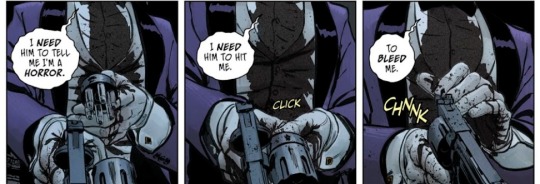
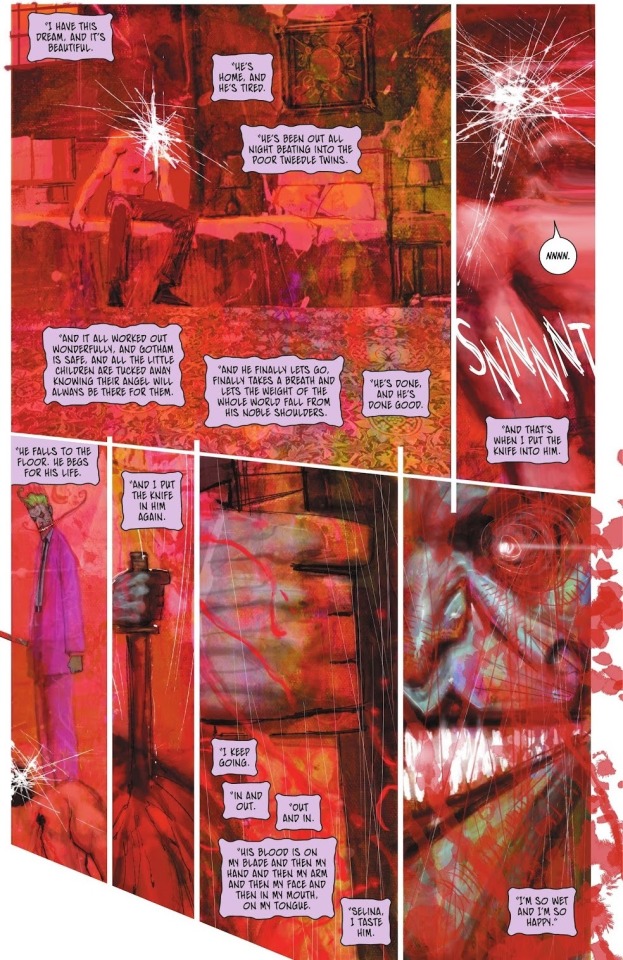

ensue, you start to wonder what is happening here exactly. Very curious indeed.
#*absolutely noone is surprised by the conclusion of this meta*#i think i wrote this meta 4 different times and i'm sure there are more apeshit panels out there#that unintentionally or intentionally drive the point home but like#the blood=cum parallel imageries in the Batjokes-y panels are driving me nuts#it's such consistent symbol throughout the comics by now#but also i'm rereading Batman Europa and uhh. uhhhh#Batjokes#Batjokes meta#Batman#Batman meta#dc joker#Joker meta
222 notes
·
View notes
Text
it's that time again
here's my analysis on the Anakt Garden artificial flowers and what they represent to the characters and story overall
the anakt flowers are consistently featured on screen throughout alnst, whether it's in the videos, official art, or the comics. they can't be shown that often if not to mean something, especially in a show as detail oriented and heavy in symbolism as alnst.

okay so there's been this theory running around that these flowers had hidden cameras in them used to monitor the children.
in the artbook, that theory was proven to be true.

so we know now that the anakt flowers are secretly cameras. seemingly innocent and beautiful decorations are used to spy on the children, a testament to the fact that they had no right to privacy, that their lives were not their own.
the fact that mizi ADORED those flowers but had no idea of their true purpose is reflective of her dream to sing in alnst. something idealized and gorgeous, but with darkness residing just beneath its exterior. she sees the world through rose colored lenses and is unaware of the evil that lurks just beneath her favorite things/dreams.
her reality is way more disturbing than she realizes, the aliens are way more cruel and invasive than what she expects, and her love for the spy devices disguised as flowers shows just that.
im not too sure if sua KNEW about the cameras, but she knew about the Snow Thing, so im gonna assume she knew abt the cameras too.
her letting mizi play with the flowers without telling her a thing and even allowing her to craft flower crowns out of them is an example of her deliberate avoidance of the truth behind alnst. through mizi's joy, she forgets about the harsh reality they live in, and escapes through that.
whenever mizi's holding them, the flowers almost look real.

the fact that she lets mizi give her flower crowns and put them on her head, and does the same in turn... she's willingly giving in to the system to keep mizi's blind-sighted joy alive. dooming them both because she can't bring herself to break the bliss.
as for till. he initially began to like the flowers because mizi likes them. till has always liked pretty things.

his talent being floral art, even if the flowers are spy devices... sort of reminds me of one of his coping mechanisms--making art that's representative of his pain.
he takes something terrible or twisted and reforms it into something pretty. something that can be appreciated rather than avoided.
(page 59 of the artbook has a quote referring to till that reads: “When I couldn't sleep because of insomnia, I could only fall asleep by squeezing out my physical strength with creation. I like to doodle, so I doodle anywhere, and I often write poetry (mainly about mizi) to support my emotions.”)
in comparison to many of the other ways till uses his hands (fighting, breaking things, playing loud and powerful melodies, etc), the way he handles the flowers is methodical. gentle. precise and careful.
we're shown his kinder side for the first time THROUGH a flower, too.

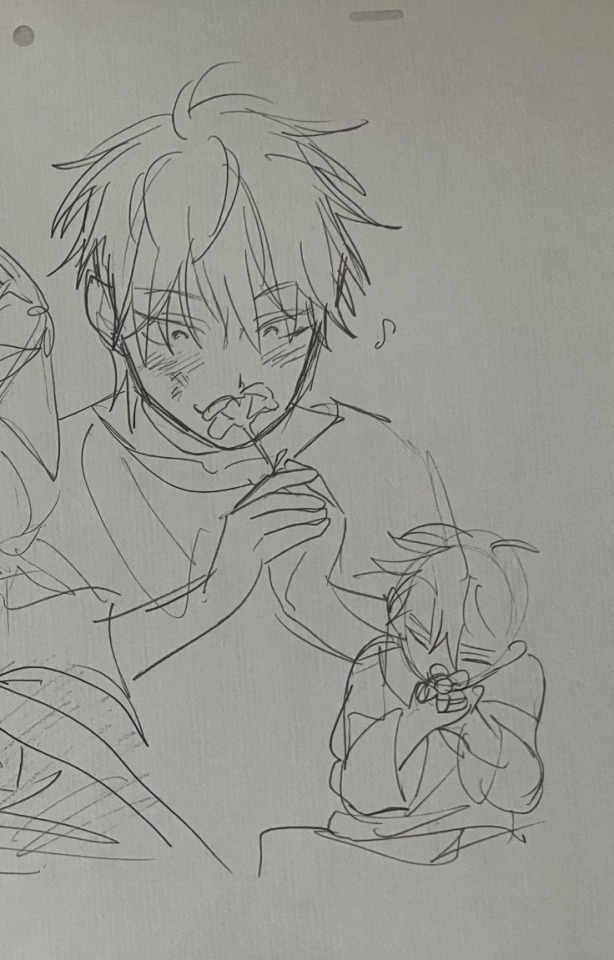
he knows his illusion is particularly fragile, so he does all he can to not mar it before getting lost in it. he uses it as a distraction.
till tends to trail behind mizi and sua with flower crowns/chains of his own because he wants to play with them as well, but he rarely makes the move to approach them.
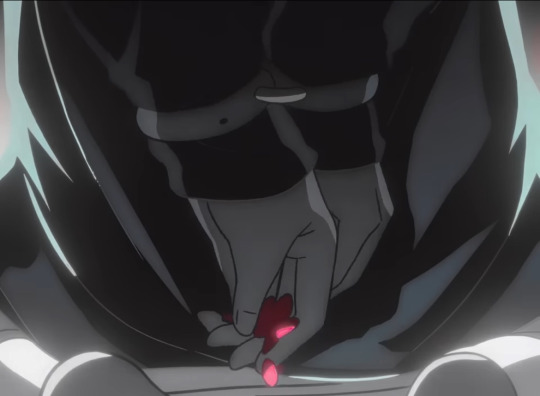
at the end of the day, the false reality, the illusion of purity, is not till's to keep. no matter how peaceful the garden may seem, there will come a period of time when till has to go back. when he must be reminded that his body doesn't belong to him.
ivan never had much interest in the flowers. in fact, he was more often shown breaking them or stomping on them rather than playing with them. (whether that's because he KNEW about the cameras or simply because he wanted to piss till off (or both) im still iffy on but there's that)

ivan has always been the most connected to reality out of the group. he sought no form of escapism, in fact, he frowned upon it (he says mizi's optimism is too much for him at times, and criticized sua for living in a wonderland despite knowing how it will inevitably end. for nurturing mizi's innocence for so long and then shattering it in the cruelest way.)
he fell in love with till, who had no choice but to face reality head on and he relates to sua, who's also had her fate sealed by the society she lives in. he's very honest to himself about these facts.
he doesn't run from suffering, having been exposed to it since infancy. no point in avoiding the truth if it's being perpetually shoved in your face all the time. he keeps it real.
no interest in the flowers, no interest in a plastic paradise. (i could find a way to tie this to that one acrylic stand of ivan eating a flower but i think that's just a silly doodle. nothing SUPER DUPER deep about it.)

(look at him. what is his PROBLEM <3)
as for the overarching meaning, flowers in general tend to symbolize innocence, purity and beauty. by that logic, FAKE flowers would symbolize a fabrication of purity.
a flower that is not only fake, but used as a spying/restriction device, a tool of oppression, symbolizes a prison painted as a paradise--such is the world of Anakt Garden.
#sorry no s49 kids but we dont know enough about them 😔😔#i COULD say something about hyun woo's grave being surrounded by those flowers#he lived and died in innocence#or something#anyways holy YAP numso#if yall have anything to add/a different interpretation PLEASEEEE lemme see#alien stage#alnst#alnst till#till alien stage#alnst mizi#mizi alien stage#sua alnst#alien stage sua#alnst ivan#ivan alien stage
49 notes
·
View notes
Text
New Symbolism Notes (Panel #0168)
With Ava's Demon being back, I think now more than ever it'd be fun to re-analyse the earlier segments with our new knowledge. This theory is basiclaly just bullet points to get my ass back in the game.
Panel #0168 has been topic for discussion since the DAWN of Ava's demon, but with the context of the last few years of updates, it'd be interesting to take a look back and re-examine this frame's contents.
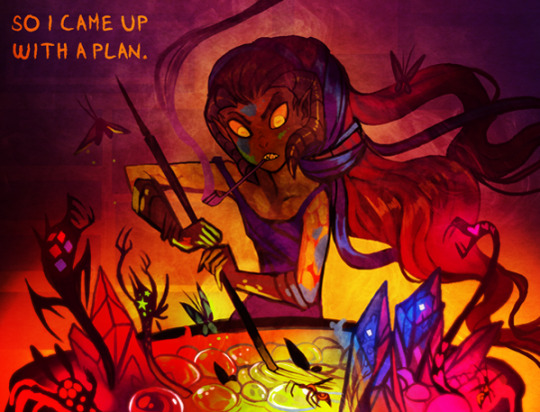
It establishes symbolism; This post for the most part, will be me recording these connections for public use since they will likel be helpful in the future.
Maggie — Green/Triangle: Association with butterflies. (Confirmed in her cast image; Not much to say here but it may come into play down the line.)
Gil — Diamonds/Blue, he's represented by the fish to the right (as also seen in cast image), but what on earth does it mean that they're in crystals??
Erios — Lime green / Stars, the creature here is bizarre... will they also become a monster of failure? Most of the others are clearly identifiable beings but this one isn't... makes me worried Gil isn't the only one we need to worry about.
Veevra — Crescent, red (connection to scavengers) is represented here by an insect looking creature? A wasp perhaps? (RE: Hivemind theory.)
AngelicPurr — Pink/Hearts, we're seeing them connected to a snake here? I'm curious how that may come into play later, especially with its fangs being bared here...
Also a bonus connection that isn't established here but is consistent throughout the comic is that Pedri is HEAVILY associated with dragonflies, and his presence is almost always proceeded by them. We've discussed this already heavily on this blog so I won't dig into it much more until we have new info on this.
#theory#avas demon#theorist#mini theory#odin arrow#gil marverde#ava ire#veevra arrvice#erios nimis#maggie lacivi#angelicpurr#symbolism notes
45 notes
·
View notes
Note
back again for more bound to want rambles. whoops <3
i'm talking about color this time
there's not much to say about part 1 since you were really consistent with the dull, hazy yellow, but i LOVE it all the same. it's like an old, worn out photograph. it fits with the messy dream vibe So Well and makes everything feel even More out of focus, adding perfectly to the effects of roses and thorns and other dream-like effects you added in place of boxy panels (ADORE IT)
i also just hfkjdhgssg i love how that color persists even AFTER vash wakes up in part 1. the messy dream lines have faded and we're snapped back into stiff, reality-ground boxes, but that hazy color is still there. still pervading everything. vash is awake now, but the dream still has him.
but then moving on to part 2, we're back to your usual color-scheme with the dark green/light pink combo... or so i THOUGHT, BUT LIKE THE ENTIRE FREAKING PART 2 IS STEEPED IN SAD GREEN HGJFKDHLGSFDSKJGHFDLKSJGHFDSLKJHGFLKDJSHG
except for 2 exceptions.
when ww sits vash down for a drink they have a pink bg, but it doesn't have that airy, happy feel that that color usually holds. there's this subtle ring of green around it, and a static effect around the outside of this little bubble of warmth. almost like they are happy to be together and share this moment despite the issues they're having, but the weight of what's going on keeps seeping in
(and ik i'm talking about color but i'm OBSESSED with the poses in this panel. ww and vash are essentially sitting the same exact way- right arm up on the table and body turned left- but they're mirrored in opposite directions. they won't face each other, even though they're exactly the same. and ww, honest in this moment, faces the camera while vash turns away. ghakfjghdsfkgjhdg)
also i lied there's more than 2 exceptions. when ww apologizes, there's this really deeeeep dark pink in the bg of the small panel vash reacts in. happiness tainted by all his pain and confliction, i assume
and this isn't pink, but i lost my MIND over that static-y spotlight effect on wolfwood in the next page. it reminds me of a few symbolism things, but i don't feel them that strongly so i'd love to know if u had anything specific in mind drawing it that way!!
but anyway a page later when vash is thinking about how "unfair" it is that he doesn't deserve ww, but ww won't leave, there's this gorgeous static, pink/green effect going on again. all these conflicted emotions and pain and want jfdhgsfdkghjdskg
but my favorite FREAKING part is after the ID, the FACE that vash makes as he finally breaks, and there's just this RING of true, soft pink around him as the green finally dissipates
and then panel 2 rolls around with wolfwood and it's almost entirely gone. barely present in the occasional "ribbon" effects that flow around the pages afterwards- still there in the background and still hanging over them- but it's okay now. that sad, painful green doesn't encompass them anymore. it's just spaced naturally throughout their lives, which is how it is for normal, healthy relationships.
i just.
AAAAAAAAAAAAAAAAAAAAAAGGGGGGGGGGGHHHHHH.
SYMBOLISM METAPHORS AND MASTERFUL DETAILWORK I COULD TALK ALL DAY ABOUT COLOR ALONE
:D!!
the color choices are also… my steps of becoming a better artist… grips fists DMGKSDMGKS BUT YES, THANK YOU FOR YOUR ANALYSIS ON BOTH PARTS!!! i'm very glad the diluted yellow could give that kind of feeling, and things are definitely more deliberate in the second part, given there's more colors now to work with!!!
vashwood consists constantly of heavy thoughts, looming agony and pending tragedy, but in these rare moments where they get to just have each other, it gets to clear and they can feel like the only two people in the world, for just a teensy tiny second! i like to build that white/pink space as a tangible place for them kind of, not always, but i realized it's a common string in my vw comics.
i'm curious to know what you were thinking of symbolically for that wolfwood spotlight panel!!! frankly, there wasn't a lot of thought behind it! it's just the narrow focus of vash now that wolfwood's in front of him and their conversation has come to a quiet, the heaviness of wolfwood's vulnerable leaving the space for a bit, leaving just wolfwood's prescence.
also thank you for sending this in particular, bc this is what made me realize i forgot page 4. AND THANK YOU ONCE AGAIN FOR YOUR LOVELY ANALYSIS!!!!! i don't have disputes, it's pretty much on the nose of what i hoped and intended for those moments to come across. i'm glad it was effective! thank you!!
15 notes
·
View notes
Text
the gabnonymous logo, explained.
i figured that this was gonna happen eventually. so in the scenario that someone brings it up, this post will be here... hopefully forever.
so... what is this? does it have a name? a personality? a style???

to put it simply, it's quite literally the first thing you'd expect it to be; it's a logo. it was designed to be a logo, nothing else. i didn't even give a name to it, other than "the gabnonymous logo".
the only thing it really represents, is my name, "gab".
the idea was to try and combine all the three letters into one symbol, a symbol anyone could do; a timeless symbol that could stand out, while still maintaining it's purpose.
the cool thing about the style i chose for the logo was the mere fact that it wasn't influenced by any trends, or anything contemporary. if i'm lucky enough i wouldn't even think about redesigning this logo. i really wanted a logo that i could stick with for the rest of my life, pretty much.
i can't give an exact date as to when this logo was made, but i can say it was made around mid-to-late 2022. i managed to find a page in one of my notebook-turned-sketchbooks that contained it's early versions and quite possibly, the first time the logo was ever conceived.

of course, with time, i refined the overall composition of the logo itself (i.e raising the top part of the inner circle so that it doesn't make contact with the outer circle).
once i had the version of the logo i was comfortable with, instead of using it as a logo, i started using it as a signature. this was evident throughout some of the sketches and comics i made in some of my other notebooks-turned-sketchbooks.
it wasn't until the creation of the gabnonymous youtube channel where i considered using the symbol as a logo instead of a signature.
the first time i used the logo as part of a video's intro was in my tribute video to technoblade:
youtube

this version of the logo, and a majority of the elements used in that video was made with a free newgrounds app named "shake art DELUXE".
after this video, i started using the channel's original, low quality version of the logo as the intro, which only really consisted of two different frames. the logo didn't achieve it's signature "wiggle" yet.
i should also mention that this version of the logo was made with krita, and it was originally supposed to be my profile picture for the live streaming platform, kick.

this version would be featured in, two videos.
with the release of my "a new era" video. the signature gabnonymous logo was born.
this version consists of two things; the now animated gabnonymous logo, in which all 3 frames were drawn in krita once again, and the font... which was also made with krita.
i love krita.
i would use this intro up to this day, well into transitioning into anime skit content.
i don't see myself updating this intro for the time being, but when given the opportunity, with better tools and experience, maybe i'll revise it, probably... i dunno. it's too iconic.
to end this off, here's a tutorial i made myself on how to make the gabnonymous logo, step by step. enjoy.

1 note
·
View note
Text
I think these are seven good categories but there's two missing which immediately that springs to my mind.
VIII. Magic as Rhetorical Symbolism
Notable examples: The War of Lost Hearts, SCP Foundation
Similar to psychology made real, except the power of a character isn't shaped by their watsonian prospective, but rather the characters powers are based on the the symbolic language of the author creating the system and characters as rhetorical devices.
Carissa Broadbent's characters don't consistently manifest magic based on their internal worldview; rather the butterflies, blood, fires, and rot function as motifs in her story's symbolic inventory as supporting subtext to the her story's textual themes.
Similarly, the anomalies within the SCP universe are mechanically inconsistent with each other except as symbolic vehicles for the thematic argument being made by the author(s) of that section of the mythos. 'Cruelty breeds cruelty' so when the benevolent chair that provides people in need of a spot to sit a spot to sit by teleporting behind them is turned into sawdust with the intent to destroy it, it now manifests inside those people's lungs instead to destroy them. etc.
IX. Magic as Narrative Archetype
Notable examples: Homestuck
Taking the idea just one step further, you have magic as a system of of archetypes which conflate a character's magical abilities with their narrative function.
Homestuck 'player' characters each have a title consisting of a class and aspect (commonly blended to classpect). The classpect both determines what magic powers the character has the potential to access over the course of the narrative and what tropes and narrative arcs a genre savvy reader can expect a that character to embody and undergo respectively.
For example, the prince class is for someone who destroys their aspect, and the aspect of hope is about the good and joyous potential utopia at the end of the narrative. So, you can expect a prince of hope to broadly speaking be a stick in the mud who ruins everyone's fun and throughout the narrative actively destroys the best potential future at several key moments; which the other characters will then have to react to in order to 'hopefully' create a new best potential future.
EDIT: After scrolling the notes, I'm seconding
Magic as The Author's Barely Disguised Kink
Notable examples: El Goonish Shive, The Wotch
Sometimes you read a work and it's really obvious that the author has written the magic system specifically to cater to their idiosyncratic combination of fantasies. Like, the level of detail put into explaining how the transformations work and what their mechanical limitations are compared to the much lighter explanations on how pew-pew wand magic etc works belies an interest in the fetishistic act of transforming or being transformed. And like no disrespect, but damn; y'all be out here writing this story, shaping it's magic system in such a way that you can safely explore the boundaries of your fetish* at a web comic artist's production schedule's pace. Good for you.
Naturally, this category also includes mature 18+ labelled works, even or perhaps especially if the author isn't attempting to disguise that the fantasy the magic provides access to is something they specifically enjoy the idea of.
*Or perhaps in some cases like transformation, exploring the boundaries of your gender identity; I'm not conflating being trans with having any particular fetish here: I'm merely pointing out the non-insignificant overlap between people who have worked through gender stuff and people who have an array of kinks and fetishes drawn from a somewhat specific pool of fetishes about sex (biological/ pseudo-biological), gender, and the transformation therein. And no judgement about that either; people are who they are and like what they like.
A Taxonomy of Magic
This is a purely and relentlessly thematic/Doylist set of categories.
The question is: What is the magic for, in this universe that was created to have magic?
Or, even better: What is nature of the fantasy that’s on display here?
Because it is, literally, fantasy. It’s pretty much always someone’s secret desire.
(NOTE: “Magic” here is being used to mean “usually actual magic that is coded as such, but also, like, psionics and superhero powers and other kinds of Weird Unnatural Stuff that has been embedded in a fictional world.”)
(NOTE: These categories often commingle and intersect. I am definitely not claiming that the boundaries between them are rigid.)
Keep reading
695 notes
·
View notes
Text
The Awakening
It was interesting to re-watch this episode because I remember being annoyed with Aang a lot during Book 3 the first time I watched this show & because the comics/parts of fandom / more thinking about it have increased my dislike for the Katara/Aang romance, I expected to be angrier at Aang. But, I actually feel like thinking about it more made me less mad at Aang for running off & behaving the way he does than the first time I watched.
I still don't think it's fair to send Katara away when she's trying desperately to help, but I get why he does it. Aang has spent the entire series learning to accept his destiny as the Avatar & a huge part of that is being a symbol of HOPE for the world. Learning that he has to be a secret now? That the world thinks that he's gone & that he failed? I can see how that would lead someone to push people away & want to do everything alone...Especially because Aang is also struggling with how awful he feels about the fall of Ba Sing Se. So, I hate how he pushes Katara away, & I hate that he tries to abandon the Gaang, but...I'm still sympathetic to him, possibly more than the first time that I watched, having put more thought into it.
Alright, shocking to no one the dynamic between the Fire Siblings is the most interesting part of this episode to me. I also found the scene where Mai checks on Zuko & tells him not to worry really cute. I need more of the Dangers Ladies Feat. Zuko as a group in my life. I'm sad we didn't see Ty Lee, but I guess there wasn't time. Zuko is struggling with fears about coming home & it shows.
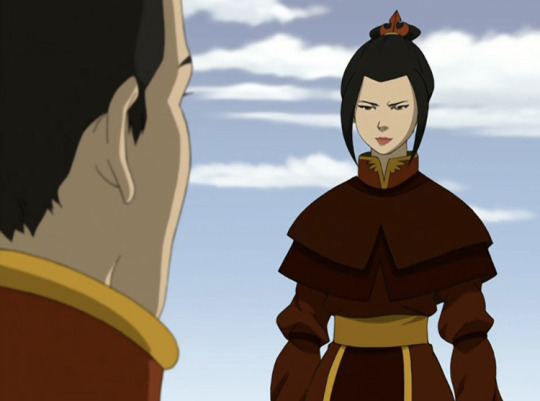
[ID: Azula standing & looking at Zuko. end id]
Alright. The turtle duck pond scene. Let's talk about it.
Everyone shut up I am thinking about how cute it is that Zuko goes right to the turtle duck pond to feed them it's probably one of the few places on the palace grounds he finds comforting...
The million-dollar question in the fandom seems to be - did Azula already know that Aang had survived?
I obviously have a bit of an agenda here I won't deny that. I'm a huge fan of Azula. I do think she was redeemable, & I have chosen fire siblings reconciliation as possibly the main focus of my fandom experience or at least A Main Focus. So, like, I'm not gonna pretend to be unbiased. BUT I do think that I've hopefully made it clear that I'm not interested in denying anything evil Azula did, or making her a victim where she wasn't, or whatever. I just like to examine character motivations & make them make sense. So - long story short - I do not think there is any way Azula could have possibly known that Aang survived before Zuko gave it away because he sucks at lying.
Let's look at the scene in context:
Azula: You seem so downcast. Has Mai gotten to you already? Though actually, Mai has been in a strangely good mood lately. [smiles]
Zuko: I haven't seen Dad yet. I haven't seen him in three years, since I was banished.
Azula: So what?
Zuko So, I didn't capture the Avatar.
Azula: Who cares? The Avatar is dead ... [Zuko looks away.] unless you think he somehow miraculously survived.
Contrast this with the way they were both welcomed home - as war heroes. Lo & Li give a huge speech about how Zuko & Azula are heroes & amazing & everyone should love them etc (& they're so right.)
I have consistently brought up Zuko's inability to lie throughout this rewatch & I think it bites him in the ass here. Azula is smart. She's a good lair herself, & she can pick up on it when other people do it - especially Zuko.
So, I think that Azula's original intention was to bring Zuko home as a war hero. She genuinely viewed Ba Sing Se as a victory & believed the Avatar was dead & the Fire Nation was doing amazing & to her, that was great. I think that what people who want to view Azula as an evil mastermind forget is that she kinda still IS one if you read it from this perspective, you just need to keep in mind her ACTUAL motivations. Azula's world doesn't revolve around bringing Zuko down, her world revolves around SERVING THE FIRE NATION & her father. Azula bringing Zuko home a hero doesn't take away her villain card or whatever it is people who refuse to see it this way are worried about. It just remains consistent with her motivations. Azula would want to see the royal family intact. You have to remember, Azula views herself & the Fire Nation as the GOOD GUYS. It's what she's been taught. They're not, & pushing Zuko to betray Iroh was objectively bad for the protagonists. But from AZULA'S perspective, she was doing a good thing for the royal family.
I also do think that yes, Azula wanted to help Zuko. The thing about Azula is that she is on the wrong side of the war, but she's not an unfeeling monster, she's a teenage girl. She likely did miss her brother & think she was doing him a huge favor.
The Bedroom Scene Tm. I said I had a controversial reading & you all assumed I meant Zucest vibes. And I did. But I also actually meant I just STILL don't view this as Azula being an evil monster lmao & I mean, that's not controversial among Azula fans, but it kinda is in the larger fandom.

[ID: Zuko glaring at Azula while she smiles. end id]
Zuko confronts Azula, & she teases him & insinuates that the Avatar might be alive. I read this as Azula trying to sus out whether the Avatar is still alive, TBH. Then, Zuko all but confirms what she already got from their turtle duck pond conversation.
So like, TLDR: Azula wasn't ORIGINALLY trying to use Zuko as a fall guy but once he made it obvious the Avatar might still be alive, THEN yeah, she was trying to save her own ass.
Oh, okay, & some quick criticisms of the #Narrative Framing or whatever...This is the first episode where we get a clear view of Zuko. I want to say that I do really love the scene between Zuko & Ozai contrasted against the scene between Katara & Hakoda, that was just an excellent parallel. It also shows us that our main villain is becoming a major player. I'm ok with Ozai as a background figure throughout Book 2, but I think that Book 3 would have been stronger if they leaned more into Ozai as the Big Bad rather than continuing to frame Azula as the Big Bad like she was in Book 2. This season we get a lot more of Azula's interiority as a character, & more sympathetic moments.
And just to be clear, I'm not against the fact that Azula is still a villain. Sorry fellow Azula Redemption truther girlies, but I'm of the belief that there was not time for her to have a redemption arc in Book 3. It could have been hinted at, we could have gotten a more hopeful ending, but there wasn't time for her to abandon her loyalty to the Fire Nation. So, I'm NOT saying "it was time for the show to STOP framing Azula as a villain." I'm SAYING.....Well, they could have given us more scenes with Ozai like the one in this episode to really concrete his spot as the Big Bad Tm. I liked what we got in this episode, I wish we could've gotten more. I guess that's what I'm trying to say.
Alright, so I've rambled enough about the Fire Nation royal family....Uh....There are other characters in this show...
I have nothing much to say about Toph or Sokka in this episode other than that Toph gets +1000 iconic behavior points for using metal bending to defend their ship. Katara gets +1000 for her use of water-bending to help. I don't dislike Sokka in this episode, he just didn't do much worth analyzing.
The only other scene that I want to focus on before I end this incredibly long review.....Is one of my favorite scenes in the series. I love the scene between Katara & Hakoda.
The entire buildup of Katara acting distant & angry from her father & talking about Aang prioritizing the greater good over what she needs & Hakoda realizing that she's talking about him too is just...STELLAR writing. I get emotional every single time. I also think that these feelings Katara is having, serve to explain further why she let Sokka reunite with their father last season rather than going herself.
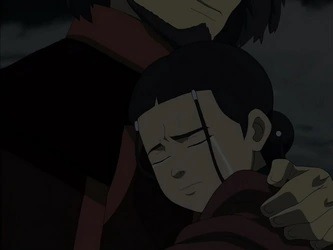
[ID: Katara crying as she hugs Hakoda. end id]
Katara: [Embraces Hakoda.] I understand why you left. I really do, and I know that you had to go, so why do I still feel this way? I'm so sad and angry and hurt!
Hakoda: I love you more than anything. You and your brother are my entire world. I thought about you every day when I was gone and every night when I went to sleep, I would lie awake missing you so much it would ache.
I'm not crying, you are.
And the ending of the episode serves as a nice thesis for the season. Aang does return to the group & agrees to go undercover. Having to hide his staff & his arrow....That's pretty sad. I think it shows how much Aang has grown throughout the series so far that he is willing to do it though. That's all I have for now!
21 notes
·
View notes
Text
Anyway, HSM2 is about internalized homophobia, and no one can tell me otherwise.
High School Musical is one of the most beloved franchises in the world. Teenagers all over the world grew up watching Troy and Gabriella harmonize together. Three movies, and nearly a decade later it’s still beloved by all. The first film easily forgotten in the ashes of the early 2000’s, the third film stuck in a purgatorial limbo of the rather unfortunate late 2000’s. The second film on the other hand sticks out between the ruckus.
The second High School Musical film takes place at Sharpay and Ryan’s family country club, during the summer between junior and senior year. The Wildcats are working summer jobs on the country club, often forced to the beck and call of Ryan and Sharpay themselves. Sharpay uses all her prestige to help Troy with college instead of starting at the bottom ( or rather, in the kitchen washing dishes) with his friends. In the time she’s helping Troy, she is also pushing her brother away; replacing him with Troy in their musical number for the talent show, and refusing to hang out with him in preference for Troy. Ryan becomes vengeful to his twin and starts hanging around the Wildcats in the kitchen. At first, he was met with some distasteful looks and words (most of which from Chad). With the help of Kelsey, and her neutral party, Ryan fits in smoothly with the other teenagers, eventually giving the WildCats all dance lessons.
Throughout the movie, the main conflict continues to be the internal conflict of Troy Bolton. He debates over and over again if he should go through with Sharpay’s shenanigans, or if he wants to “listen to my own heart.” This of course involves Gabriella, as she is Troy’s love interest. She’s not in the second film except for the beginning, then, where she leaves in the middle of the film - in order to create angst for Troy - then when she shows up again in the finally to sing/rejoin Troy.
The conflict in the second film is the combining of Troy’s two worlds. His first - his main world in the first movie, that hence became his secondary world - which is represented by Chad. Then his secondary world - which becomes his main world in this movie - which is represented by Ryan. Chad represents Troy’s masculinity, or his more idealized version of himself. Ryan represents Troy’s femininity or his current version of reality. These two worlds collide in the iconic song “I don’t dance”.
Since this movie - and hence this scene - came out in the early 2000’s, a lot of the innuendoes went over people's heads. Luckily, as the children who watched this movie grew older and more experienced, and the world became more accepting, we’re able to see this song for what it is.
Before getting into the lore and symbolism of the iconic “I Don’t Dance” sequence, context is needed. For most of human history, homosexuality was seen as a sin in all places except ancient times (see: Greece and Japan). The modern age is the most accepting on all fronts, such as sexual orientation, race, and religion. In the early 2000’s, High School Musical director Kenny Ortega was not publicialy out yet. He wouldn’t be till 2014.
Originally, while writing this, my first thought was that Kenny - the director - would be using Troy as a y/n type character to project his insecurities and struggles with masculinity, and what that means in defining his orientation and societal views that would be placed upon him. Then, it came to me later that this is in fact not the case, Troy (and Gabriella - who is in fact a y/n character for the female audience) is more of a character for a man of his time, confused with his own ideals of masculinity and the views of society because, “oh god, I can’t like theater/drama because only queer people and girls like it!” The second point is pushed further with the Troy and Sharpay sub-plot. Sharpay tries to further Troy’s career as a basketball player, though that’s not what he wants anymore, and Troy is no longer sure if that is what he ever wanted to begin with (enter the song “Bet on it” and the hilarious meme “no dad, I’m giving up on your dream”).
Keeping these things in mind - Kenney’s queerness, and Troy’s struggle to realize you can in fact sing and be a heterosexual, wow, revolutionary - it became clear to me that Kenney’s y/n characters were Ryan and Chad.
For those who aren’t into the arts, or find them too difficult after a singular attempt thinking they could write a world class novel on the first go, let me be the first to tell you every author has a y/n character. First, for those who don’t know what y/n stands for, it’s a popular fanfiction trope where a writer will write a story about a character dating, being friends, and so on, with the reader. The y/n stands for “your name” so anyone can be the main character in this story at any time. For a writer of mainstream fictional work, such as High School Musical, Game Of Thrones, Lord Of The Rings, Pride and Prejudice, Harry Potter, Hunger Games, even most comics. Now, most writers or directors aren’t going to be as obvious as having a character not named (or named y/n) or even named Jane (looking at you Jane Austin), the y/n character of many mainstream authors/directors/comic artists and so on is usually the character they feel or have given the most attributes similar to themselves.
It’s the same reason people have favourite characters. You see a fictional character and you either 1. Want to Bob the Builder them, 2. Some sort of weird sex thing, or 3. See more/the most of yourself in this character. Number three - thankfully - is usually the main reason. Some people just create their own favourite characters. An even easier way to think about this, is just projection baby, that’s psych 101.
Before I went off on a small tangent of fictional works and how human emotion plays into creating them (except anything Disney has made in the past decade, and no you can’t change my mind on that) I mentioned that Chad and Ryan are Kenney’s y/n characters. As a queer person myself, it’s clear for me to see the different struggles each of these characters face and how these reflect the queer experience.
So, let’s finally get into it.
Ryan, without it being explicitly said is clearly a character of what people in the early 2000s think a gay man is. He is effeminate, wearing bright coloured outfits with lots of accessories - namely his signature hats - he is also in the theater department doing musicals, and passive/subservient to any of his twin sisters' wills. Yes, now we know gay men aren’t just feminized men, but in the early 2000’s a gay man who can do "masculine" things like change their car oil, like sports, and so on, break the "effeminate" stereotype thus confused many cishet people. Sharpay is painted as more confident - or, for sake of comparability - masculine to her twin in the first movie, and most of the second movie. Making Ryan a bit of her dog who would do anything to get by - painting Ryan as lesser than human, once more, playing into the homophobia of the early 2000's.
Despite the clear stereotypes playing into his character, Ryan is consistently one of the most confident characters in the movie. The other, being his sister of course. This confidence in himself is what gravitates the other characters towards him, either by being intimidated (Troy, thinking Ryan and Gabriella were a thing), or admiration (Chad, by the end of “I don’t dance”).
Chad, on the other hand, is a whole different ball game. While he is confident in the first movie, and the first portion of the second movie, he begins to break more and more when Ryan becomes a more integral part of the Wildcat group. To keep in mind, Chad is also the most vocal about his distaste for Troy’s artistic past-time. When the other Wildcats join Ryan and begin learning how to dance for the talent show at the end of the movie, Chad is also the most vocal about his distaste. The baseball game where “I don’t dance” takes place, is the climax of Chad’s arc and his turn towards acceptance to Ryan/Troy’s hobbies.
Of course, there is more to the “I don’t dance” sequence than just Chad’s realization - the exact one Troy comes to terms with in the second movie as well - of “oh my god I don’t have to be gay to enjoy stereotypical ‘feminine’ things.” That is the main part of the song though, that and all the sexual tension.
Going back to what I’ve stated previously, Chad and Ryan are Kenney’s projection or y/n characters. Let me do a small recap before we get into the nitty gritty of the famous “I don’t dance” video.
Thinking back to the first few paragraphs, I stated that Kenney wasn’t publicly out till 2014, about 7 years after the second movie came out. This could be due to the fact that a) it’s the early 2000’s and everyones still very homophobic, or b) self-doubt that comes with the queer experience. The most likely reason is a mixture of both of these. Because of this, Ryan is the more self-assured version, or idealized version of Kenney that he wants to be. Ryan is confident, never being swayed about his lifestyle (could be read as: sexuality) even though Chad - and most of the wildcats in the first movie - put him through relentless “teasing” and humiliation. He’s confident, almost to a fault, he’s sure of himself, and yet still reaches out a hand to Chad and the other wildcats to show them that they’re just being, kinda dick-ish.
Every queer person wants to be Ryan. Despite his heavily stereotyped characterization, I personally believe he is one of the stronger written characters in the movies, mainly due to Kenney putting the time in to really make Ryan feel like a real person, to give himself some sort of relief of his own anxieties, a chance to see the world through a person who truly has no fear. Unlike Kenney himself.
This is where Chad comes in.
Chad is seen as “confident” in the first movie, the second Troy “leaves” basketball though, all that confidence comes crashing down. His best friend has another hobby - one he thinks is “not right” (it’s okay, you can say gay), - they wont be spending all their time together (first, can you say dependent relationship much, yikes).Chad’s defining characteristic up until their fight that instigate act three of the second movie, is being Troy’s best friend. I’m going to take this as if this were truly the case, and not a decently written character arch. Some people base themselves around their friends and their whole identity on being a friend, that they lose sight of themselves, this mainly in high school of course, when your whole world is really nothing but school, and friends. Newly developed independence is there, but that’s scary, so instead of worrying about the future, cling to something that’s reliable. I’ve seen this happen, mainly at the end of high school, when the “real world” is coming a bit too close for comfort. This could generally be the case if a person is lonely, but for timeline sake I’m going to say Chad has got some anxiety about graduating (considering the second movie takes place the summer of junior year).
His lashing out at Troy’s hobbies and at Troy’s neglectful friendship, make more sense with that background, and are seen more in the second movie where Troy begins spending all his spare time with Sharpay (trying to collect that BAG!). Chad - and others (read: father) - insists that music is not a feasible career option, and Troy should just stick with basketball (like...that is a feasible career option). The tension Chad creates in the studio only grows when the other wildcats decide to take up Ryan’s offer for dance lessons and move from the kitchen, to helping out with the talent show. (Next essay idea: how high school musical two was really about class all along, cause Jesus).
Chad is the less obvious option for a y/n character. Though again, the 2000’s were not as cool people like to pretend they are. Chad - for Kenney - represents what he actually feels, this fear of being rejected for how he is and how he chooses to live his life/lifestyle, so he sticks to something reliable. Ryan is new, and exciting, and confident in a way that Kenney/Chad wish they could be, but in order for that to happen they need to understand that maybe people are complex creatures, and can enjoy multiple hobbies (aka: the same lesson Troy is teaching the viewers, but far less boring). But, for Kenney/Chad facing that thought and that realization is scary, and thus, they lash out at anyone (read this paragraph as: Chad mad jealous of Ryan cause Ryan bomb as fuck).
All this build up, finally comes ahead in the employee baseball match
******
The baseball game is probably the most memorable scene in the whole High School Musical franchise (minus Sharpay’s “Fabulous” solo, but that’s also from the same movie, and it’s kinda rude to give what’s already the best more points); the tension in the scene, and what it implies makes it the best written segment of all three movies, let alone the most entertaining.
Some things to keep in mind from our background information: Chad is missing his bestie and struggling with what being “masculine” really means for him and others. Ryan of course makes this confusing, because the traditional method is being thrown out the window. In short, Chad has internalized homophobia, and Ryan being open - or as open as Disney would let him - is causing all sorts of problems.
Despite the song, “I don’t dance” being logged into our collective skulls for all eternity (you’re probably humming it right now, sorry about that), the very brief interaction of Ryan and Chad before the game is lost on the public consciousness. The two are clearly comfortable with each other, though the distaste seems to be on Chad’s side more than Ryans. So, the two start playfully jabbing at each other before deciding to do a bat toss to see who will be in the outfield first.
Before they begin the bat toss, Ryan says “You don’t think dancing takes some game?” Chad then very clearly checks him out, doing a simple but effective ‘drag-your-eyes-over-them-top-to-bottom-then-smile’ and says “you got game?” (Seen in gif below)
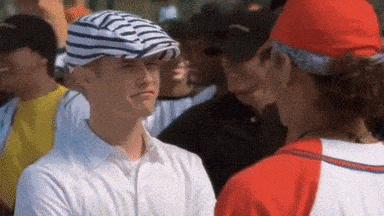
I don’t know how much you know about sex metaphors and how many of those baseball has in it (seriously though, it’s a lot), but with the bat toss, Ryan’s hand ended up on top, and Chad’s under Ryan’s. Let’s ignore this for now, it’ll be implied again later. Ryan’s team starts out in the outfield because he won the bat toss, and hence, the song officially starts.
The first lyrics (ignoring the chores of “hey batter batter, hey batter batter, swing”) is
I'll show you that it's one and the same
Baseball, dancing, same game
It's easy
Step up to the place, start swingin
This part is sung by Ryan, who is taunting Chad out in the outfield. Before the game, as stated, Chad was taunting Ryan about his lack of “game” (both sexual and not sexual metaphor are implied), and now, Ryan has turned those tables around. Baseball - is seen as more masculine than dancing, not as masculine as football or basketball, but it’s up there. Chad is someone who cares about his masculinity, enough to the point that Ryan playing baseball makes him loose his mind. Makes him question his own personal definition of masculinity, if you will.
Ryan says, “baseball, dancing, same game,” impyling that, to him, baseball and dancing are one and the same. That is baffling to Chad, cause well, how can something meant for girls even be close to something meant for boys.
Chad comes back with:
I wanna play ball now, and that's all
This is what I do
It ain't no dance that you can show me, yeah
This only proves my previous point.
I had a conversation with myself about this, and I’ve decided not to include it in this essay, but a second essay may or may not be possible. Basically the premise - the dancing/”musical” moments of High School Musical are conjured up images by those meant to see them (ie: like a visual hallucination, but, not really) but this scene kinda poo-poos that idea.
Now, the thing I am talking about is Ryan and Chad’s peacocking at each other during the time they sing these lyrics. The movements they’re making could be mistaken for dancing - as we automatically assume it is because of the title and themes of the movie - or it could be them just getting ready for the baseball game. Ryan swings his leg over the pitcher's mound, tossing the ball up and down into his glove, making wavy hand gestures, etc. Chad brushes off his gloves, swings his legs, hits the bat on each foot, and so on.
For the peacocking, Chad makes a mock of the ballerina foot stance before strutting over to the home plate. Ryan laughs at this, which earns quite the smirk from Chad himself (see gif below).
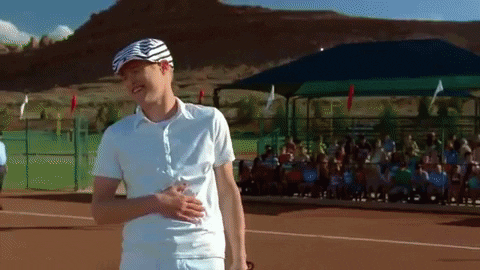
This is when it becomes a conversation.
You'll never know - R
Oh I know - Ch
If you never try - R
There's just one little thing - Ch
That stops me every time, yeah - Ch
Come on - Ch
When Chad says “Come on” it’s when Ryan throws the baseball at him, starting the game, and giving Chad’s team their first strike of the game (get it, it’s funny). Now, obviously we need to talk about the “there’s just one little thing that stops me every time.” As a queer person, I assure you, two of the things that kept me from living my Best Life were 1) my own ignorance of what asexuality was and 2) the fear that everyone I love would hate me for who I am, and what I have no control over.
Sorry to get deep like that on main, but, can any other queer person say different? Obviously, your first point may differ, but my point still stands. In the video/scene there is a very short moment (to which I have condensed into a gif for you all, you’re welcome, and I’m sorry about the quality in advance), of the camera moving over to Chad’s team (or his friends in this case since it’s an employee baseball game) as he says this line (gif below).
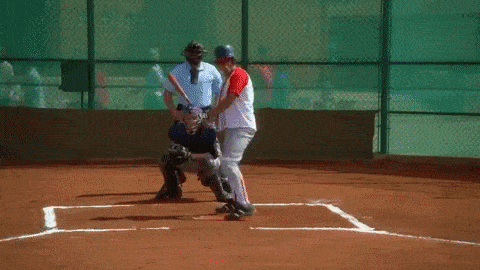
I will not be explaining the use of subtly in this essay, but I’m sure you get the metaphor Kenney is trying to use. If not, let me spell it out for you in very simple words. This song has a lot of sexual innuendos (as mentioned pervious with the baseball bat scene and still, more to come), with that in mind, and clearly queer themes at play (as mentioned before, again), this scene only shows Chad isn’t as straight as he leads on. His fear/phobia of Ryan/the arts come from a much deeper place.
In shorter, and much simpler terms: Chad queer.
But, let’s get back to the boy's conversation.
I don't dance - Ch
I know you can - R
Not a chance, no - Ch
If I could do this, well, you could do that - R
Translation: “If I can do this weird, sweaty, dirty, Male thing without blowing a fuse, you can and should be able to dance just fine.”
But I don't dance - Ch
Hit it out of the park - Both
I don't dance - Ch
I say you can - R
There's not a chance, oh - Ch
Slide home, you score, swingin on the dance floor - Both
I don't dance, no - Ch (This is just the chores, you’ll see it multiple times throughout the essay, I just figured if the song is going to be in your head, go all the way right).
Two-steppin, now you're up to bat - R
Bases loaded, do your dance - R
Here we are with the baseball metaphors you’ve all been waiting for ladies and gentlemen. Girls, gays, and non-binary pals. For those who have somehow managed a sheltered existence with access to the internet, lemme help you. Ryan is talking about “loaded bases” both in the context of the game (where it shows each base has one person from Chad’s team on them) and in the term of sex. While you go out there dating - while it’s mostly douche bags and people using it ironically - your nosey friends may ask you how far you got.
“First, second, or third base?” They may ask. Or something like, “oh wow, did you get to home plate/base?” These are simply the rankings of the stages of a sexual relationship. First - kissing, sometimes just handholding, Second - making out, some light groping, Third - full on groping, no clothes come off, but it gets close. While each person has different boundaries, these are the general accepted definitions for the bases.
Home base is obviously full blown sexual intercourse. Since Chad has his “bases loaded” it means he’s done all these things before, just never gone completely to sexual intercourse with someone - in the terms of the song and the history we’ve already established, it’s most likely a male character. This is only proven by Chad’s uncomfortable nature towards Ryan (internalized Homophobia, thank you, returning theme) but his easy, and cocky personality towards everyone else. “bUt thAt DoEsnT pRovE” hush, that’s the final cherry on top. Remember this conversation.
It's easy - R
Again. Previous points have been made.
Take your best shot, just hit it - Ch
I've got what it takes, playin my game - Ch
So you better spin that pitch - Ch
You're gonna throw me, yeah - Ch
I'll show you how I swing - Ch
Ah, the famous “I’ll show you how i swing” a very strong baseball metaphor for everyone. Keeps queer people from defining themselves to dangerous (straight) people, and, well, that’s it actually. This term is mostly used by bi/pan people, though if you want to stay in the closet or are in a dangerous place, it is also used to subtly tell other queer people you are in fact, not straight. My favourite is when this term came into play when President Buchanan got elected in 1856 (for those that don’t know, he’s the first and only gay president).
You'll never know - R
Oh I know - Ch
If you never try - R
There's just one little thing - Ch
That stops me every time, yeah - Ch
This is again, the same lyric as before it doesn’t pan, and the tone is much different. The camera stays on Chad as he says this line, meaning he’s reflecting, he is now his own problem, the person that is keeping him back. His friends are not on his mind anymore, which is good, Ryan’s Gay Propaganda has been working.
Come on - Ch
I don't dance - Ch
I know you can - R
Not a chance, no, no - Ch
If I could do this, well, you could do that - R
But I don't dance - Ch
Hit it out of the park - R
I don't dance - Ch
I say you can - R
There's not a chance, oh no - Ch
Slide home, you score, swingin on the dance floor - Both
I don't dance, no - Ch
Lean back, tuck it in, take a chance - R
Swing it out, spin around, do the dance - R
I wanna play ball, not dance hall - Ch
I'm makin a triple, not a curtain cal - Chl
I can prove it to you til you know it's true - R
'Cause I can swing it, I can bring it to the diamond too - R
You're talkin a lot, show me what you got - Ch
Again, like the beginning of this song, this is a heavy base for flirting and sexual tension, which this song is drowning in.
Stop swinging - both
Hey - both
This is the part where they all start a flash mob in the middle of the baseball diamond. Again, alluding to the conversation I had to myself earlier, this only proves my own theory as no one takes notice of this. But, that’s not this essay, this is where I mention how close Chad and Ryan are at the end of the group dance.
Come on, swing it like this - both
Oh, swing - both
Jitterbug, just like that - both
That's what I mean, that's how you swing - both
You make a good pitch but I don't believe - both
Here is yet another (and the final) sexual innuendo. This is actually a rather quick one. Pitching in queer culture is considered the person who tops (because queer people even had to straight-ify their sex lives to “top” and “bottom”), this is the person who is giving, if you know what I’m saying.
I say you can - R
I know I can't - Ch
I don't dance - Ch
You can do it - R
I don't dance, no - Ch
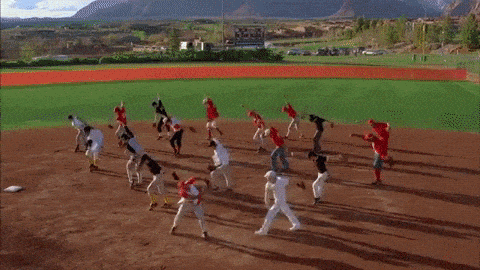
Here is where that mosh pit ends, and how they get a little too close to comfort.
Nothing to it, atta boy, atta boy, yeah - both
The rest of this song is simply a mash-up of the baseball game being finished, and this lovely gem.
Now, clearly, Chad’s self conscious nature towards his sexuality is gone, he’s sitting close - if not squishing - Ryan, and talking to him like they’ve been friends forever. Take note of the change of close, most likely due to all the tension at the end of the song, and maybe a little of Chad’s own natural human curiosity built in. Now, I leave you with this note:
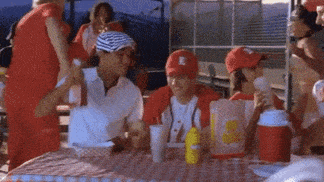
If there is anything that confirms all this more, its Chad’s girlfriend wearing the pride colours.
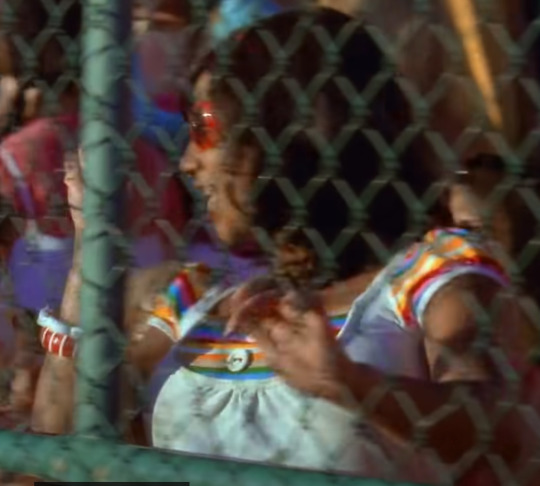
Also note: this could also be seen as a friend helping his bro discover his sexuality and fighting internalized homophobia, but, that’s ignoring the sexual tension, so go off I guess.
Thank you for coming to my TED talk.
Watch the full thing here
#high school musical 2#ryan and chad#do they have a ship name?#troy bolton#high school musical#the original not the remake or whatever the kids have now#ryan evans#chad danforth#Sharpay evans#troy x gabriella#ryan/chad#that baseball scene#yall know what i'm talking about#i don't dance#the gayest scene ever#and gayest song#Anyways: the series#should I write that second essay?#thanks for coming to my ted talk
245 notes
·
View notes
Text
✨ | I'm Fallin' For You, Darling.
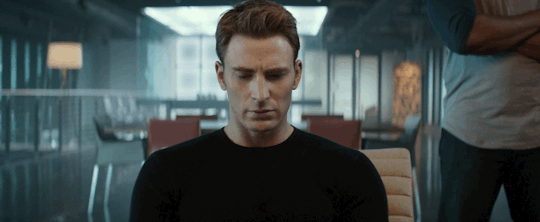
Click [100 Followers Fic] for the rest of the 100 follower fics :)
Pairing: Chris Evans x female!reader
Summary: Both you and Chris have quite the relationship, it all started the day you gave him a marker.
Word Count: 3.5k
Warning(s): Fluffffff, Angst for sure, talk of anxiety (not a lot but also a lot).
A/N: Thank you guys so much for 100 followers! It means the world, I hope you like this one as much as I do. (Sorry that's a lotta words).
⤑ Click here for my taglist so you can be notified when my new fics are posted.
Any Likes, Comments & Reblogs are super duper appreciated :))
When Chris Evans is nervous, there is only one thing that calms him down. And that one thing is you and the fact that you allow him to doodle on your hands all the time.
The premiere of Captain America: The Winter Soldier was the first time you saw Chris so nervous. Him constantly rubbing his hands together or bouncing his leg underneath the press table and the times when he'd fiddle with the hem of his shirts. These were things you noticed Chris did when he got nervous, and it seemed that you were the only one who witnessed them.
The third day into the film's press tour, you decided to take matters into your own hands. You knew what it felt like to be anxious, the feeling settling within the depths of your stomach or the constant avoidance of looking out to an audience. Sometimes you'd excuse yourself a few times throughout interviews just to catch your own breath.
~
The whole TCA: TWS cast sat along the stage of the comic-con panel. The hosts introduced you all, crowds cheering loudly when they saw everyone.
You took your seat next to Chris, who was already fiddling with his plastic water bottle that he'd been gripping so tightly on, you could already see the indents on the bottle. You smiled, looking out to the audience waving back to some of your fans that you could see holding signs up for you in the crowd. It was, in fact, times like these that your anxiety shot right out the window, replacing that anxiety with happiness and admiration of your fan base.
Five minutes into the panel talk and questions were directed to Scarlett and RDJ. You knew you wouldn't be talking anytime soon as, of course, like all other press tours, the interviews were heavily coordinated. So before you'd have the chance to speak, Sebastian, Anthony, and the Russo brother would go first. Sitting back in your chair, you took a sip of your water, your eyes following down to where Chris was bouncing his leg. Then, setting your water back onto the table, you pulled yourself and your chair closer to the table, reaching over across Joe Russo, who observed what you were doing.
"Could you pass me the marker, please, Joe?" you whispered to him; he smiled, nodding handing you the marker. "Thanks", you whispered again.
You returned to the comfort of your seat, Scarlett and RDJ still bantering. You look forward to the audience and give a tiny little smile to the fans who were waving at you. Your eyes looked down to your arm; you wrote a little message on your forearm, so he knew what the pen was for.
You scooted a bit closer to Chris just enough so you could hand him the pen. You lightly looked over to him; your hand went underneath the table and across to rest on Chris' lap. It was right there when his leg stopped bouncing. You held the pen in your hand, waiting for him to take it from you. Chris looked up turning his gaze to you; you gave him a smile nodding.
His eyes directed back down to where your arm was. He read the note you had written for him, 'Use my arm to doodle. It helps with anxiety :)'. He let out a smile, all the while letting out the breath he'd been holding in.
You looked back up and over to Sebastian, who was now talking; you felt the pen slip out from your grip, the marker clicked and the coldish ink embracing the surface of your skin.
One of Chris' hand rested firmly on your forearm to keep it from moving, and the other used to doodle. That was the first time in the history of you knowing Chris to be calm and content. No bouncing his leg or fidgeting. He was completely aware of everything instead of his growing anxiety.
~
It was after that moment Chris slowly began to fall in love. He never expected someone to notice his worries and do something about them. But, the way you sat there while he doodled on your arm didn't phase you at all, you wanted to support him, and you showed him that you did.
Years later, It became a force of habit, the tiny hugs you'd give Chris just to slide a marker into his pocket before going on stage. The small slight movements he'd make before he took your hand into his so he could draw.
You'd become someone who knew him better than he knew himself. The many dates he took you on lead to you moving in with him. The small moments you both had messing around on set and loving him in the silliest of moments meant eternity to the pair of you. You knew that you had fallen in love with Chris Evans, and so was he. You both just didn't realise that the moment would be a forever moment. If you hadn't offered him a marker that day, where would you be?
It was now the premiere of Avengers: End Game and the last press tour you'd have for a while. Today's interview consisted of a comic-con panel, the same panel you happily let Chris doodle on your arm five years ago.
You both sat together, his hand protectively on your thigh. You were speaking into the mic as a fan had just asked you a question about possibly seeing your character in the future of the MCU. Chris sat there attentive to your voice while he drew on the top of your hand. It was a little duck with a Boston Red Sox hat holding a heart.
Once you had finished answering the question and someone else began to speak, you looked back down to see what Chris was drawing. You squinted in wonder; looking back at Chris, you wondered why he was drawing this. Coincidentally, you had drawn a duck on him one day in between an interview—a duck holding a heart wearing a NASA cap. Chris looked at you with his cheesy smile. Oh! he was up to something, you thought. Chuckling, you watched him colour in the small heart with a red marker. He was, in truth, quite a good artist; you managed to take a photo of all his doodles over the years. But this one, this doodle was a bit different; it meant something more to you.
After you had both finished the panel, you were set on getting a new tattoo. Kissing Chris' lips, you told him that you'd see him at home. Chris had asked you where you were going, so you said you were going out to dinner with your mum in town, which was true you just left out the part of you going to get another tattoo. Your parents were in for the weekend for reasons unknown and wanted to see you before they left, so you had already planned to see them. He nodded, kissing you once more before departing ways.
You both were always so sentimental, and you knew as soon as you saw that duck in a red sox cap holding a heart on your hand that you wanted it to be a forever doodle. That day, when you had drawn a duck on him, he went and got it tatted on his hand the same day. The first tattoo visible on Chris' body, the only tattoo that wasn't hidden under his shirts. In contrast, most of your tattoos were on your arms and wrists; this was another tattoo among the few others you had on your hand, others being the original six symbol and some writing of your favourite quotes.
Before you knew it, you were sitting on the chair in your private tattoo artist's studio, getting the duck tattooed on you forever. The tattoo was a reminder of memories both you and him had experienced together.
~
The red sox hat, being where he took you on your first date five years ago. To a Red Sox game, of course. You didn't have anything to wear to represent the team, so Chris kindly offered you his Red Sox cap to wear; five years later, Chris had to purchase a new hat because you kept his one. Of course, he didn't mind; he loved to see you dressed in things that were his; the hat was one of them.
"I don't have anything to wear", you sadly pouted at Chris, looking at him in his Red Sox jersey and cap.
He looked down to you as you stood next to him, holding his hand softly, looking out to the stadium. He smiled, taking his cap off and placing it over your head.
"Now you do", he smiled, leading you down the stairs to your seats. You weren't really a fan of baseball. Still, once you had experienced your first game, oh man... it became a routine for both you and Chris to attend every game the Red Sox were playing at.
~
The duck, the furry little animal you had brought home a few months after you had first moved in with Chris two years ago. In all honesty, you wanted to get a turtle, but as soon as you saw that slight yellow fluff waddling around at the pet store, you wanted nothing more than to take it home with you. Chris couldn't say no to you, so the duck became your baby.
"y/n?" Chris came around the corner where you'd sat yourself talking to the little duck... Chris had been looking for you for almost fifteen minutes when he found you sitting there with the pet shop worker.
The excitement in your eyes told him that you had forgotten all about the turtle. You looked up at him smiling, patting the empty seat next to him. He sat watching you pet the small baby duck with your thumb lightly. "I'm naming him Alfie" you smiled brightly, looking back at Chris.
He took the duck out of your hands and chuckled, "Alfie, it is".
~
The red heart...
A reminder of how much you both loved each other. Something that had never gone away, the love both you and Chris had continued, it grew stronger over time, of course with a few hiccups here and there but never enough to break that love. But this, the tiny little heart being tattooed onto you, was one similar to the heart that homed your middle finger on a ring. The rose gold ring he gifted you when he asked you to be his girlfriend four years ago.
You rested your head on Chris' shoulder as both of you watched the office. A new series you'd been watching together, it was a few months after your first date with Chris, and you both were head over heels with each other.
"Hey y/n", he whispered.
"Mh?"
"I'm fallin' for you darling."
You lifted your head from his shoulder, looking up at him, "You're what", you whispered softly, you heard what he said, but you just needed to hear it again.
He brought the small box out, opening it to reveal a rose gold band hearts making up the band. "I said I'm falling in love with you", he smiled before continuing ", Be my girlfriend?" he sweetly asked.
You chuckled, letting him slide the ring onto your middle finger. "Of course", you whispered back to him before cupping his face. You both looked at each other, you saw it, you saw the life you'd been wanting. It was with him.
"I love you".
~
Sitting at the dinner table with your parents, you briefly looked down at the now wrapped tattoo on your hand. You had thanked your tattoo artist for another fantastic job; the new ink was precisely how Chris drew it on you earlier today. Your parents were eating away and so were you.
"It's great to see you again, Hunny", your dad spoke.
You smiled, nodding. "I've missed you guys so much."
"What's on your agenda for this weekend?" you spoke again, taking a bite of your food. Your mum and dad took one look at each other before your mum stopped to talk.
"Your dad and I are going to old friends party", she smiled at you. "party", you chuckled. "Since when do you guys party".
"it's an engagement party, I mean... do you have some parties we could go to" your dad joked.
"First of all... no." you laughed, cringing at the image in your head of your parents dancing and drinking. "But that's nice. I hope you both have fun, wish whoever a congratulations for me" you smiled.
"Oh, we will", your mum outwardly said. You took a second to squint your eyes in curiosity to your mum's tone. "Mhkay".
~
It was the end of dinner, and you had parted ways with your parents, taking a Cab to the home you shared with Chris. "thank you, driver," you smiled, hopping out of the cab walking up to your driveway. You giggled, seeing Dodger patiently waiting for you at the front door. "Hey buddy", you smiled, opening up the door for him to jump all over you.
Closing the door behind you, kneeling down to cuddle your pup. Dodger wagged his tail giving you kisses. "Shhhhh", you chuckled lightly, "were you waiting for me, huh?" you watched Dodger roll around on the floor. You stood up, taking your shoes off, leaving your keys on the hook. "C'mon, baby", you whispered, gesturing for Dodger to follow. You both walked down the hall, Dodger by your side.
You could hear the snores coming from your room and knew Chris was already sleeping. You opened the door, looking down at Dodger "go keep my spot warm for me, please", you sweetly asked your pup, who did just that. You watched him gently jump up onto the bed and curl up on your side of the bed.
Walking further down the hall, you went to take a shower. Changing into the PJs you left on the warming rack in the bathroom, you followed back out to check on Alfie, who would be sleeping in your office. Once that was done, you head into your and Chris' room. You took off your slippers and ushered Dodger to sleep in his bed. You kissed his head before he left. "night, bubba".
You slide in next to Chris, who had his back to you. Covering yourself with the blanket, you slide one arm around his bare torso pulling yourself closer to him. He was so warm, and you loved it. Chris groaned, turning over. He smiled sleepily. "Hey hon, how was dinner?" "It was good", you kissed his lips, "That's good," he said, pulling you into his arms to cuddle.
"Hey babe"
"mhhh", he mumbled in a sleepy voice.
"I love you."
"I love you too".
~
The next day you were doing a panel with the marvel cast. Like any other day, you answered questions, so why did you feel this one would be different. You were a bit nervous today, like you had woken up wrong, or you were waiting for something to happen. You didn't know if that was a good or bad thing.
You were talking to your audience. It was a large panel today consisting of the MCU cast, if not all of them. Maybe that's why you were so nervous; the bigger the cast panel, the bigger audience to speak to. "Make eye contact and hand gestures y/n," you thought to yourself right before you begun to answer the fan's questions. You start to use your hands gesturing when a fan had asked you about your character's personality.
Chris smiled, watching you intently; fans noticed. But as you were gesturing, he noticed the tattoo. He had to double-take when he saw your hand, leaving a small on his face. After you finished your question, he leaned in. "I love your tattoo, babe", he whispered; his comment calmed your nerves a bit as you chuckled ", just following your lead."
You both lean back into your seats as Joe and Anthony Russo began the next half of the panel. You were already forty minutes through... only another forty to go.
Anthony spoke, "As you may know, this will be the last you'll see of your favourite actors and actresses for a while..." Joe turned to the entire panel. "So we put together a little something of your time over the last decade" Joe turns back to the audience. "So sit back and relax."
The panel turned their chairs to watch the big screen, the lights dimmed, and the video rolled. It was a decade gag-reel of everyone in the MCU; Chris had pulled your chair closer to his; he knew you were nervous, for what reason? He didn't know, and neither did you. He should've been the nervous one; he was about to do something in front of the entire audience he had been planning for months.
Your head rested on Chris' shoulder, laughing with everyone else as the embarrassing footage rolled through. There was more footage of you and Chris than anyone else, but again, you were too clouded in worry. You didn't overthink about it.
Then there it was, a clip you didn't know existed—a video of you dancing with Scarlett and Jeremy on the infinity war set. You were being videoed from afar, but Chris comes into the frame making funny faces before pointing at you. You blushed a bit, laughing lightly.
"You see her", Past Chris spoke to the camera. "One day, I am going to marry her" he wiggles his finger over to your past self, who was still dancing around like an idiot. You swear your heart stopped, so ultimately, you started bouncing your leg. The video stopped, and the lights came back on. There were hushed voices; you knew they were looking your way, but you couldn't tell why.
You turned your chair, trying to avoid whoever was looking at you. Not noticing anything, nobody was talking. You had turned your head to look down to the end of the panel where The Russo brothers were. They were all looking in your direction, including the whole cast panel. You jumped slightly when Chris caught your leg mid-bounce; you turned to look at him, his eyes dazzling before you. Oh, that smile, you knew that smile all too well. Chris was smiling like a little kid.
Chris tapped you on your thigh, which caught your attention, so you looked down. This is it; this is the same feeling you felt when he first asked you to be his girlfriend. You burst into tears after reading the message on his arm; Chris' forearm rested in your lap while holding a black marker in his hand. You sniffed, looking softly at him. He was now in tears too. Taking the black marker from his grip, you clicked it; resting your hand on his forearm to steady yourself, you answered his question.
'Will you marry me, y/n?' the question written in his bold writing stared right back at you.
You always had your answer 'of course.'
You closed the lid on the pen, and Chris opened his hand; your engagement ring sat in the nook of his palm. He slides it onto your ring finger right next to your rose-gold one. You smile blinking through the tears, you turn to him, and Chris had already stood with his arms in the air.
"SHE SAID YES"
The whole audience got up cheering; he leaned in, cupping your cheeks, both of you laughing through your kisses. He had lifted you into his arms, spinning you around. He set you back down; you wiped the tears from your face laughing while wearing your t-shirt. At that point, you knew everyone was in on your proposal; you turned to your cast members, who were all clapping.
"Give a round of applause for the future Mr and Mrs Evans!" Joe spoke.
You went around hugging everyone who had gotten up just to congratulate the pair of you. One by one, your friends embraced you in their arms.
"Congratulations", two-voice spoke from behind you, "oh my god, you idiots", you chuckled, pulling your parents into a big hug. Chris stood next to you as your dad pulled him into a hug. "Your fiancé sends her congratulations", he laughed, referencing the conversation you had with them last night.
Chris looked down at you, "They had texted me last night what you had said. I'm surprised you didn't catch on", he laughed. "I- I didn't know... I was curious after mum said it so suspiciously but didn't think," you mentally face-palmed yourself.
And like that, the panel was concluded. Everyone congratulating you and Chris before leaving. Chris had set up a little engagement party back at your house; everyone was enjoying their time having fun. You sat on Chris' lap still in shock, his arms wrapped around your waist "you didn't see that coming, did you?" he smirked, looking up at you.
"No... no, I didn't" you laughed sweetly. Your hand ran over Chris' forearm where it still had both his and your writing on it. "That was the best proposal ever" you looked at him, smiling, "I'm glad, darling" you both leaned into each other, lips connecting softly.
"I've fallen deeply in love with you, Mr Evans".
"I'm still falling for you".
------------------------------------------------------------------------------
Chris Evans Taglist: @buckyswintersoldiermask @lharrietg @buckyfan12 @afraid-to-be-me @fairityretro
#teebarnesfics#chris evans one shot#chris evans x female reader#chris evans x y/n#chris evans x reader#chris evans fluff#chris evans x you#chris evans#chris evans fic#chris x y/n#chris x you#cevans#chris evans angst
395 notes
·
View notes
Text
The Shared Dalek Universe of the 1960s: A Case Study
In 2011 (a little over ten years ago!), El Sandifer cited my dearly-beloved 1960s Who Annuals as examples of stories which ended up influencing the TV series many years down the line despite making an unrepentant hash of continuity.
Her first example is that the Doctor is called Dr. Who, and that he alternates between being from Earth on one page, and not being from Earth three pages later. I would point out that TV was doing much the same thing in those days, and went on flip-flopping basically until Jon Pertwee, so it’s not a terribly good argument to begin with.
However, she spends more time pondering the Daleks of the comics. These Daleks, she notes, are very different from those on television at the time. There are hordes of them, they travel in fleets of saucers, and they’re ruled by the Emperor. This contradiction, she argues, later fed back into the TV series in the RTD era, when huge fleets of Daleks became the norm and, earlier but still well after the first burst of Annuals, in the form of Patrick Troughton facing a very different Dalek Emperor in The Evil of the Daleks.
In no way do I wish to undermine Sandifer’s ultimate conclusion that “canon” in the sense of diegetic consistency is a red herring of little importance, and what matters for any sane definition of ‘canon’ is whether a story is referenced at all, not whether it’s contradicted.
However.
Having gone back to 1966′s The Dalek Outer Space Book, I have made a very startling discovery, in the story entitled The Secret of the Emperor. The rest is after the cut; I will leave you with a delightful panel from this story, showing the “bewildered” Dalek Emperor being bullied by knights at the Battle of Agincourt. (This is one of my favourite Doctor Who images ever, and if it doesn’t put a smile on your face I am not sure I want to take you seriously.)
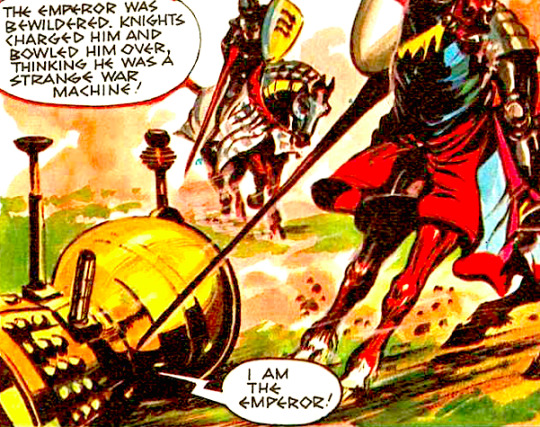
So, famously, when he debuted in the comics, the Dalek Emperor was not the giant, static Dalek later shown on television in The Evil of the Daleks and The Bad Wolf of the Ways; instead, he was golden, squat, and had a bulbous head; to house all the ego, one expects.
Thus, most people will point at the fact that when the Doctor met “the Emperor” in The Evil of the Daleks, he resided in a huge tower-like casing in the Dalek City, as evidence that although ideas received a first treatment in the comics which later made it to screens, no direct continuity was intended; the comics’ Emperor was an alternate, a first draft, to be discarded once a more definitive TV portrayal emerged.
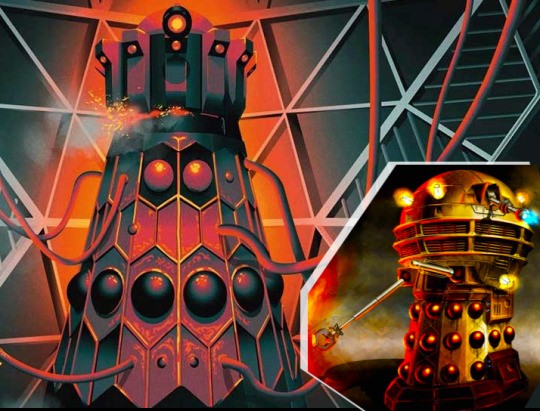
And yet, of course, it is somehow appealing to think of the two as the same Dalek, isn’t it? John Peel (Dalek writer voted most likely to be a 19th century Victorian man who stumbled into a time eddy; it’s mostly the remarkable sideburns) spent a lot of time in his Dalek novels establishing the life story of the Dalek Prime, the First Dalek Ever, who transitioned from the globe-headed casing to the towery Evil one and then deeply regretted it, what with the “getting killed by his own infighting troops with no way to escape”.
But this is usually viewed as a retcon. A cute retcon, an admirable retcon even, but a retcon. My good friend and esteemed fellow canon-welder, @rassilon-imprimatur, espoused such a view four years ago:
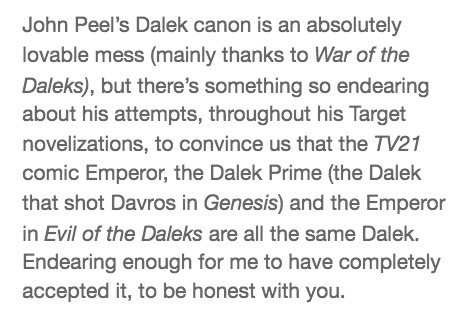
Well, all of this is, if you’ll pardon my French, bollocks. John Peel didn’t make anything up, except for the snappy name of “the Dalek Prime” as a designation for the individual. The Dalek Emperor in Evil of the Daleks was always the Emperor of the 1960s comics, and there is a very good reason for his seemingly-contradictory change of appearance. What’s more, I am not talking about murky authorial intent: these are things that the discerning Dalek fan in 1967 was meant to have known.
Let me wind back the clock to 1966. A Dalek master-plan is unfurling, a multi-media agenda spanning several years, more ambitious perhaps than even Time Lord Victorious in its scope; for the ultimate aim of a small cabal of men including David Whitaker, Terry Nation and Brad Ashton is nothing less than spinning the Daleks out of Doctor Who and into their own non-BBC TV show — to be made in America, and in colour, if you please!
For over a year now, a Dalek story arc has been running in the pages of TV Century 21, tracking the early rise of the Dalek Empire and its early interactions with 2060s humanity. Though the Daleks encroach over other parts of the book, including the headline stories, the bulk of this story arc comes in the form of weekly one-page comics making up one long serialised history of the Daleks, under the minimalist title of The Daleks.

Also under the solo brand of “The Daleks”: Annuals, an exclusive audio story, and, of course, toys. Time for Phase Two. It is time to end the Daleks’ endless confrontations with Dr Who on television, and set the stage for a new status quo able to support the TV series Nation dreams about.
Important background: Terry Nation, famously, does not like the Dalek Emperor. Whitaker made him up without consulting Nation, who maintains that the highest rank in the Dalek hierarchy should be the Dalek Supreme. The Emperor was hard to do away with in the comics, since he was basically the protagonist of the TV21 strip, but one imagines Nation was keen to jettison him from the world of the planned TV series.
I am speculating, of course, but I picture Nation sitting in his office, pondering the two great thorns in the side of the Independant Daleks Masterplan.
Thorn one: the Daleks are entangled with the Doctor both diegetically and symbolically; unless something can be done, the Daleks will remain “the Doctor’s enemies”, and a show where they commit evil and the Doctor fails to show up would ring false with the kids watching. The Daleks must be removed from Doctor Who in a sensational and definitive manner, or the whole enterprise is a nonstarter.
Thorn two: I, Terry Nation, have foolishly allowed David Whitaker to shape the lore of the Daleks, and he has made this Dalek Emperor guy very central to early Dalek history, leading up to the 22nd century Dalek Invasion of Earth that most of the Doctor’s subsequent conflicts with the Daleks have stemmed from. But I do not like the Dalek Emperor. I wish I could get rid of him in my new status quo.
…………Aha.
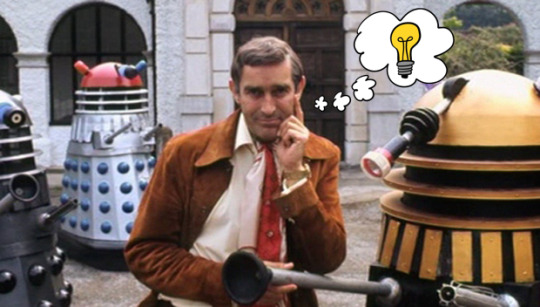
A triumphant Terry Nation adds a post-it note to the ever-widening corkboard representing the multimedia Dalek Masterplan setting up the TV series, which must already include things like “convince Jean Marsh to come back as Sara Kingdom”. Notes distilled from this corkboard will form the backbone of The Dalek Outer Space Book, this year’s Dalek annual, which exists principally to set up the prospective main characters of the new TV series: Sara Kingdom and Agent Mark Seven, of the Space Security Service.
The new post-it note reads:
Construe the Daleks’ enmity with the Doctor as a personal enmity between the Doctor and the Emperor, a la Sherlock Holmes and Moriarty. Have the Doctor triumph over the Emperor on TV in a big ‘event’ story.
Result: the Doctor-vs-Daleks storyline is over; the Emperor is dead; I get everything I ever wanted.
(Except maybe a pony.)
Then he phones David Whitaker, smirking all the while like an evil genie preparing to grant a badly-worded wish.
“Good news, old chap, I’ve decided you can write a new Dalek story for the BBC, all by yourself. I promise I won’t interfere.”
*confused and delighted David Whitaker noises*
“ And you can even bring in that Dalek Emperor of yours. Yes, you heard me!”
*Whitaker enthusiasm intensifies*
“Ahhh, but there’s a catch. The Dalek Emperor must DIE.”
Of course, like all good Faustian bargains, this is irresistible even though it is ruinous and the victim knows it to be ruinous. Whitaker agrees to the scheme. He and Nation begin planning out the events of the great finale of the Dalek-Doctor confrontation, which will hit the screens in 1967 as the mildly racist, but otherwise quite well-loved, ‘The Evil of the Daleks’.
Quickly enough, it is decided that Patrick Troughton crouching to berate the short and bubble-headed Golden Emperor would look silly. If the Emperor appears on TV, alongside human performers, then it should tower over them. Besides, this is to be the archvillainous Dalek Emperor’s last stand, and certain traditions must be followed.
Hence another task is added to the bucketlist of the Dalek Outer Space Book: tell the story of how the Emperor transformed from the globe-headed dwarf to some huge and terrible towering form under the Dalek City, for the Doctor to stumble onto later. This rebuilt Emperor may be teased, but must not be truly seen or truly defeated in the book; that would defeat the whole idea.
Hence, The Secret of the Emperor, a story which sees the Emperor becoming self-conscious about his own efficiency and letting the Scientist Daleks rebuild his casing from scratch. The final page is a splash panel, a delightfully nonsensical diagram of the mechanical components of the new casing.
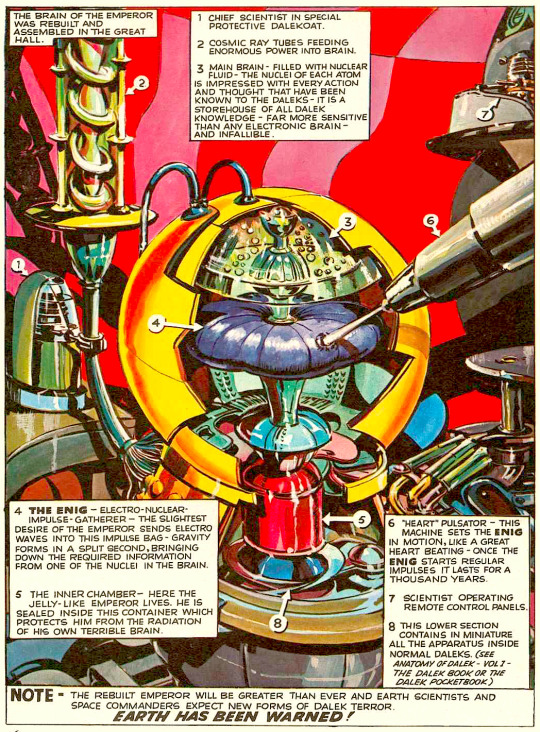
The almost surreal array of colours and shapes is so arresting as to obscure an important detai. Many have seen this page over and over, and yet still missed it. The recent(ish) ‘Anatomy of the New Dalek Emperor’ artwork from Time Lord Victorious clearly looked at this page for reference, in spite of the fact that the TLV Emperor is much more inspired by the old Emperor than the rebuilt one.
Let me spell it out for you: look at the Scientist Daleks in the top right and centre-left. Look at them.
The new Emperor is huge.
And what else?
That Scientist on the left is plugging huge wires snaking from the wall into the tower-casing.
He now resides in the Great Hall of the Dalek City.
The background wall is a weird checkered pattern.
In addition, the following facts are seeded throughout the earlier pages of The Secret of the Emperor.
The point of moving to the new casing was to grant the Emperor increased brain capacity (suitable for concocting masterplans).
He acquired said increased brain capacity to help the Daleks attempt to overcome humanity once and for all.
The Emperor has recently had a trautmatic but eye-opening experience with time travel.
Ignore the fact that the Emperor was here depicted with what appears to be a still fairly bulbous, and golden, head, and it doesn’t take a genius to figure out that this is very, very direct setup for how the Doctor finds the Dalek Emperor in The Evil of the Daleks — tower-like, in an imperial throneroom in the Dalek City, with a checkered wall pattern, planning out a complicated scheme to harness time travel as a means of defeating humanity once and for all!
Yes, the designs don’t quite match — but how could the artist behind the visuals of Secret of the Emperor have known precisely what Shawcraft would build, a year later, based on the same basic description by Nation & Whitaker? The parallels far outweigh the minor differences in execution. (It’s worth noting that elsewhere in the Outer Space Book a different artist drew what was clearly intended to be the Golden Emperor as a large, golden, but normally-proportioned Dalek, so it’s not like the visual descriptions of these scripts were exceedingly precise…)
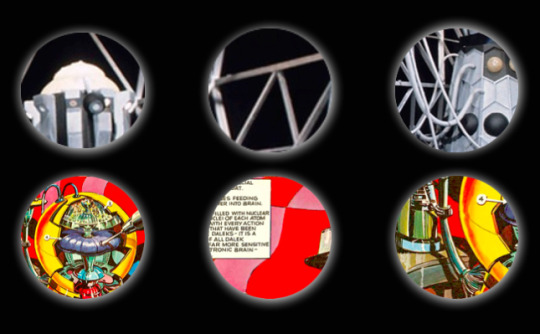
The rebuilt Emperor is never seen in the Outer Space Book outside of this ‘dissection’: he is heard throughout The Brain Tappers but kept carefully off-panel, and his new and dangerous new casing is pointedly not destroyed in the story’s conclusion. Well, of course not. That’s what Dr Who is for.
tl;dr: it is not a post hoc retcon, or even a secret, that the round-headed Emperor of the comics became the Dalek Emperor of Evil of the Daleks. A holistic view of the state of Dalek media in 1966-1967 shows that, in fact, it was the whole point that this be the Emperor of the comics; and that the comics had begun setting this up long before Patrick Troughton encountered Edward Waterfield on TV.
And thus, to circle back to Sandifer’s 2011 post, it is not enough to simply say that the “seemingly non-canon” comics inspired the show down the line. In fact in this instance, what appeared on Doctor Who existed for the benefit of the Daleks spin-off — not vice-versa!
#Daleks#Canon-Welding#Doctor Who#Analysis#Doctor Who Meta#Dalek Emperor#Dalek Prime#The Evil of the Daleks#Terry Nation#David Whitaker#Brad Ashton#The Secret of the Emperor#El Sandifer#Canon#Jacob Black
76 notes
·
View notes
Text
Incredible Numerology Coincidences in AOT and some that aren't
Numbers 139, 13, and 33 (and a few others in between)
Disclaimer: I'm not, by any means, stating that Yams planned every little thing that I'm going to mention, nor that he went as far as I did in terms of numerology research or everything extra I found here! I just wrote this stuff because I found some coincidental things really interesting, and I love digging deep into random stuff!
I explore things in depth for purely for the sake of exploring them in depth LMAO
Number 139
Since last year, the announcement of the end of Attack on Titan brought up an intriguing theory: Isayama would end AOT manga serialization purposefully on chapter number 139 because of its numerology meaning.
For those who don't know about it, I'll resume here:
According to numerology, the number 139 means the end of a cycle and death (but more like rebirth/renovation and not necessarily "bad" death).
Furthermore, in numerology, individual numbers and sums are important.
Then, as we keep breaking down number 139, though and apply directly to AOT world, we also have this:
13 = the maximum number of years of the life of a Titan shifter;
9 = total number of Titan shifters
Nice right?
But we also have this:
The sequence 1 - 3 - 9 can be applied as 1 Founder was eaten by her 3 Children that then generated the 9 Titan Shifters.
139 = 1+3+9 = 4 + 9 = 13
And these numeric coincidences were why AOT Reddit groups predicted that Yams would probably end the manga in 139! Turns out they were right: Attack on Titan really ended in the number 139!
However, there is still some unsolved stuff to look into...
So, driven by the wildest personal observations possible, now I'm taking things to another level - and a little warning ⚠️ for this post will run a little wild with numbers and Math and crazy observations 😜
Let's go crazy with it but don't take it too serious!
Number 13
Interestingly, the number 139 also has a dreadful meaning coming from the first two numbers, aka 13, that has some dark meanings representing bad luck, treason, lawlessness, rebellion, and again, death. The reason why we have as examples people fearing Friday 13, or the 13th card of Tarot, which is named as nothing other than "Death".

Death, The 13th card of Rider-Waite-Smith Tarot deck.
Curiously, Yams once used a literal Tarot symbol in the manga as he drew Berthold sleeping like the Tarot card 12, The Hanged Man (chapter 97). But back to number 13, coincidentally or not?, Erwin Smith was the 13th Commander of Survey Corps, and he "betrayed" people because his main dream was proving his father's theory, and he is the first character to present us the visual concept of dead comrades watching the ones alive, making a full connection between life, death and afterlife.
Additionally, while I was curiously looking up at the Tarot card above, I would say in the additional frames in the anime on Eren's dream they used the element of Tarot card 13 - the roses in the curtains resemble a simplified form of the rose in the flag in the Death card above, doesn't it? Or is it a coincidence?

Eren's long dream in Episode 01 (2013). Also, say hi to Niccolo, the fallen Masterchef
At the middle right of card 13, there is also the sun halfway down on the horizon, aka sunset. It is referred to as the end of cycles and rebirth mostly, but there are so much more symbols involved! And Yams has made many, many uses of the sun/ sunset/ moon/ night/ stars/ sunrise and their multiple meanings throughout the manga - including the many comic book covers, chapter names, some anime endings like these two, and even in Mikasa's part on the first AOT guidebook. (A more complete "sunny and celestial bodies" analysis has been sleeping in my drafts since March, when I studied some falcon mythologies lol)

Coming back to numbers, though...
...Last year, after 128 months of consistent publication of the manga, AOT had to skip one month of release (chapter 129, on May 9, 2020) due to the COVID pandemic.
This resulted in a curious thing that coincidentally added to the iconic number 139:
Instead of the manga ending on 03/09, chapter 139 was officially published on 04/09.
And 4 + 9 = 13.
Kinda cool, right? Yams just keep stumbling upon number 13 again and again!
BUT it might not be only that...
Well, at this point, we all know Yams changed AOT ending from the first one, which would be like "The Mist" end. So - again - I'm not saying what I will show here is the 1st thought Yams had for everything of the plot or what he planned back in 2009. I'm seeing things that might have a slight root in the past but that ultimately just happened coincidentally or not because of the present circumstances (like, from 2017 - when Yams said he changed the end up to now.)
In his first interviews, Yams stated that, though he didn't flesh things out until he is working on the chapter to be published, he had planned the plot and overall major point to be told in the volumes ahead of his deadlines.
So, if we assume Yams had a small draft or outline of the story up until the final chapter, and think that AOT might have indeed ended on the wrong date due to the chapter delay, we also have these other intriguing number coincidences with the EMA trio:
Armin's painful inner monologue was in chapter 135 - it should have been in his birthday month;
Mikasa's painful inner monologue, shared dream with Eren, and she ultimately killing him were in chapter 138 - it should have been in her birthday month;
Eren's long monologue, "full death" and AOT end were in chapter 139 - it should have been in his birthday month.
In the hypothesis this is true, our 03 main characters might have been meant to get their narrative hurting them the most in a way to represent the death/end of a cycle and rebirth/new beginning in the month of their "birthdays". Interestingly, since chapter 139 was supposed to end the AOT story in the same month as Eren's birthday, this gives off an even heavier feeling that Yams did want to do this "end the AOT cycle" together with Eren, right?
BUT , again, it might not be only that...
I always felt very intrigued by how Yams emphasize the idea of "being born into this world" many times through the manga. But for me, the most unforgettable scene when talking about this topic is when Carla answers Shadis about how Eren (or anyone) didn't have to necessarily do great things in life because being born already meant he was great (chapter 71).



So then, when we remember Yams planned to make Grisha holding baby Eren as the last panel of AOT...

...it kinda feels like this would make a matching call back to that moment in chapter 71. Thus, whatever Yams would write to get here in this point would complement Carla's dialog, or something similar because this is Grisha holding baby (or newborn) Eren and saying "You're free".
Of course, back in 2017, Yams also said that this last panel could change by the end of the story. And yes, it did change at least three times now as he drew Mikasa with the scarf in chapter 139 v.01, but in a recent interview said he had lastly planned to do the EMA kids version running to the tree, and (SPOILER) now we ultimately have the unknown kid, and his dog, and Eren's tree. And also, we all know the original AOT final was changed to one more peaceful because Yams had mentioned in interviews he wanted to be more responsible toward his readers.
However, Yams still made use of Grisha's panel - it's just that he transformed this huge panel into a tiny piece of drawing during Eren's long explanation in chapter 139. Unfortunately, it seems the weight of these ideas of being born and all kind of diminished and got lost because of that. Like, the way things ended up, this panel was placed in a way that seems to say "you know what, there is not much space left in this long explanation that Eren is giving, so better just fit it here and end this..."

In fact, this whole Armin x Eren convo just had way too much stuff to take all in the little space-time of this chapter. So when we get to this specific bit, the Grisha sequence looks like some piece of one last riddle that will have to go down the AOT piece unanswered - together with the unforgettable "only Ymir knows".
Of course, this is one way to view things, as there must be many metas and analyses explaining this scene somewhere. However, this Grisha sequence just kept bugging me to no end, especially because before that Eren justified or explained things with "I don’t know " and "Only Ymir knows" - and heck - that wasn't anywhere near what a curious person waiting so many years to make sense of things would expect to read!!
So I questioned myself many times about this, always trying to somehow dig out anything that could give me more answers as well as add more significance to Grisha's words and Eren's birth scene. And I even looked up again at Eren's name meaning because AOT character names are also food for crazy theory-starving brains like mine. But I overlooked seeking out for possible hidden connection into the second scene...
...because it had never, NEVER occurred to me that - looking beyond the words and more into the drawing context - these panels might have been hinting at a connection with the literal date of birth of Eren.
And when I looked up to numerology, I found some interesting coincidences, or aren't they?.
For better context, according to Numerology, there are three numbers essential to your life, and they all come from your birthday:
Day of Birth Number —the day of the month you were born
Life Purpose Number —the total sum of your full birth date
Destiny Number —the total sum of letters in your birth certificate name
In other words, the number of the day, month, year, and letters in your name are important to determine these 03 things.
Now, I know it will look like I'm just making a mess out of this to fit into the following observations because:
1) I won't consider the characters' year of birth since AOT major reference data number is the Fall of Wall Maria, which definitely must have its own meaning;
2) It doesn't seem the year of birth is much concern to Yams as characters like Erwin, Levi and Hanji don't even have their ages clearly stated; and it looks way too much work to any creator to do this.
3) I won't look into Destiny Number because the way characters names are written vary in at least 03 ways (Like Eren Yeager / エレン·イェーガー/ Eren Yēgā).
However, just testing some crazy and disparate theories is nice, so here we go!
Eren's birthday
Eren's birthday is 03/30;
His birth number is 3 (because 3 + 0 = 3)
Without the year, his life purpose number is 3 + 3 + 0 = 6
But when we experimentally sum his birthday number in a more literal way, we get 3 + 30 = 33
Now, let's break down a bit of this all...
We all know that Eren was a slave to the story. Interestingly, the meanings of number 33 make a nice call back to this:
33 is considered a Master Number, seen as the number of the Cosmic Guardian;
33 is considered a call to divine powers;
33 is the number of vertebrae in our spinal column, which is the backbone of the human body.
Eren has many (or at least 4 major) moments where he wonders about being special, being the salvation and hope of humanity, and he has this "savior" (or I prefer saying destroyer) complex within him that appears near the battle peaks of the manga. He even questions himself about how he hated titans but promptly accepted as his the power of the titans.
And at the end of the story, Eren had 3 extraordinary titan powers: The Founder (The Titan "Number 1"), The Attack Titan (that gained the ability to "travel through time"), and The War Hammer (endless ability to create objects out of imagination). So his character has all attributes of a God of Creation (as well as Destruction).
Considering Levi spent a full month in the forest with Zeke, and then the catastrophe happened, with the Rumbling going for about 3 days, we could also consider that Eren accomplished his call to fate/choice in 33 days considering he settled that the Rumbling was bound to happen since the night of the Declaration of War.
So, in other words, Eren was ultimately born to do something grand (either horrible or not) but instead of fatefully being prone to become the Great Good, he was "free" to become the Great Evil. As his name says, the "Holy Hunter".
But number 33 is also considered the number of unconditional love and the Selfless Giver. And of course, Eren is the total opposite of it. However, if we break the number like 3 + 3, we get a pair of numbers 3 making it, right?
Now, guess who else has number 3 on their birthdates?
Yes - Mikasa and Armin!
(But it's just another coincidence!)
Mikasa's birthday
Mikasa's birthday is 02/10
Birth number is 1 (1+0 = 1)
And 2 + 1 + 0 = 3
As well as 2 + 10 = 12 (= 3)
In short, Mikasa was the first character Yams drew. Number 12 represents completion and entirety. And who killed Eren and freed Ymir? Yes, our Mikasa!
Armin's birthday
Armin's birthday is 11/03
Like Eren, his date of birth is 3
And 3 + 1 + 1 = 5
As well as 3 + 11 = 14
Coincidentally, number 14 appears on Commander Erwin's birthday (10/14), and is also in the sum of Commander Hanji's birthday (09/05).
Another coincidence: number 5 symbolizes God's grace. Hanji's birth date is 05, and her name also means "God is gracious". And Erwin has number 5 on his birth date sum. Interesting, huh?
A non-coincidence, though, is how Levi sees Armin being so like Hanji and Erwin in chapter 136 while he is talking about the meaning of their devoted hearts.
On the other hand, Armin is the 15th SC Commander. And something that caught my attention was how the Tarot Card Number 15, aka "The Devil", somehow seems to a bit of a recall to this scene:

Interestingly, while the animal in the Devil card is a goat, in the manga (Xsaver's Titan) we have a bighorn sheep, which is very fitting. Because if it was a goat titan, they would mean immediately associated with the real Devil, and make the Eldians ultimate demons. On the other hand, if it was a lamb titan, it would be 100% opposite to the goat/Devil in religious meaning, and since everybody in AOT had "bloody hands" if Yams had used a lamb it would be a representation of holy purity that can't actually be attributed to Xsaver/the Beast Titan itself, nor any other AOT character.
Anyway, here Armin is in his human form in the hands of the Bighorn Sheep Titan that passed to Zeke the plan to euthanize the Eldians, and the BST is being held in the hands of the God of Destruction aka the Colossal Titan, that started all SnK tragedy, together with 02 Attack Titans. So though small, almost incapacitated and in his tiny human form, Armin shows that it's thanks to the humanity within people that humanity will be saved.
Gosh, this panel is really, really full of symbols, much than this, but let's leave it for another day.
Coming back to Mikasa, Armin, and number 33, then, we also have this nice concept pointed out in its meaning as the Selfless Giver: it gives unconditional love.
This is the kind of love that says to anyone who crosses your path, "I accept you and love you no matter what you do or don't do. I will always continue to love you regardless." (Book: The Ultimate Guide to Numerology)
I think at least 90% of AOT readers got shocked seeing Mikasa kissing Eren's decapitated head in chapter 138 and reading Armin thanking Eren in chapter 139. But in sum, Mikasa (and her Life Purpose Number 3) and Armin (with his Date of birth number 3) did exactly what number 33 meant to Eren.
In their different but complementary roles as part of the MCs triad, they formed the number 33 that ultimately ended the cursed path of the first and last holders of the Founder - with Mikasa "releasing" Eren's human/titan body, and Armin, Eren's mind and heart or soul (cof cof if he ever had one xD).
And to finish things, individually, number 3 means trinity.
Three is the first number to which the meaning “all” was given. It is The Triad, being the number of the whole as it contains the beginning, a middle and an end. The power of three is universal and is the tripartide nature of the world as heaven, earth, and waters. It is human as body, soul and spirit.
In the first three numbers, all of the others are synthesized. From the union of oneness and duality (which is its reflection), that is, from triad, proceed all of the other numbers, and from this primordial triangle all figures derive. (x)
OOF--
That's it for some of the crazy coincidences of numbers 139, 13, and 33 in AOT! I humbly thank you for reading up until here!
BUT...
If I hadn't broken your mind with boredom, craziness, or disparate ideas and wild connections, and before I see myself out to an asylum, I gotcha a bonus with the characters I love the most in AOT: Hanji Zoë and Levi Ackerman.
Other interesting points that the chapter delay might have possibly affected:
Bonus 01: Hanji's farewell and death literally and figuratively representing the last flight of the "Wings of Freedom". It was in the chapter of this same name and number 132 - that ultimately marked 11 years of AOT being published. And due to the delay, it also ended up being published in her birthday month.
However, if the chapter had been posted on 08/09, it would have made a nice coincidental number parallel sum with AOT 1st chapter: the Colossus Titan destroyed Wall Maria in 845 = 8 + 9 = 17. Which also becomes 1+7 = 8.
Number 8 is a vertical version of the infinite symbol ( ∞ ). According to the book "The Ultimate Guide to Numerology", number 8 can be seen "as two windows", where the circle above means the spiritual and the bottom the material. Number 8 is also the number of the letter H, and to numerology, the shape of the letter H symbolizes the two worlds or plans (above and below) connecting.
Coincidentally or not, Hanji died and met the other Survey Corps dead members right in this chapter, making a FULL connection between the realm of the living and the dead. They were really watching them.
Additionally,
"the symbol of infinity is also reflected in the balance of justice and honor that 8 people represent. They have a very advanced sense of what is ethical and true, representing honor, impartiality, and dignity in everything they say and do" [Ibid].
I think it's easy to see how Hans beautifully and sadly embodied all these qualities, especially in chapter 127 when she was stating genocide was wrong and how none of their SC fallen comrades would have supported that crime. Not coincidentally, Hans is the center of the cover of volume 32 (and now I suspect it is also related to Tarot Card number 17), and even though all these crazy number things most probably have nothing to do with it, it ends up particularly nice reinforcing why Hans is the only SC member (now Alliance) wearing the green-winged cloak. She embodied the full meaning of the Survey Corps and the "Dedicate your hearts" battle cry motto.
Also - still in the hypothesis that the chapters wouldn't have changed after the delay - chapter 133, "Sinners" would be published on the anniversary of AOT. Chapter 1 is called "To you, 2,000 years from now". Just by putting these two titles side by side, I can already draw so much stuff to write about. For brevity here, I won't. But just think about it as if the chapters were literally talking to each other... (starting by "To you, sinners, 2,000 years from now".)
Bonus 2: Levi's painful inner monologue was in chapter 136, "Devote your hearts" - it should have been in his birthday month;
Everybody knows what is celebrated on Levi's birthday: the ultimate sacrifice, devotion, and hope for a better world - to put it simply. Things that Levi wonders with his heart broken, and his ultimate pain as he remembers his SC fallen comrades.
And in this chapter, Levi represented the last SC vet alive while also clearly giving the ultimate signs the SC had lost their wings as he was almost incapacitated to keep fighting with his bad leg and other injuries. (I would like to write a lot more here, but I'm saving it to my chapter 136 analysis, so that's it).
Bonus 3: in AOT last comic book cover, we have 3 interesting numbers on display:
This is volume 34, we have the 3 kids on one side and 9 on the other. They are all running toward the tree where everything began and ended. That is, except for Eren, who is already there...

Number 34 can be reduced to 3+4 = 7, considered the number of perfection mostly because is the number of days within God completed all Earth creation. (But no, I'm not saying Yams is a god lol)
There is 3 + 9 = 12. As we have seen in Mikasa's part, 12 represents completion and entirety. But here, this number also hints that since the kids didn't get to the cursed number 13, they are safe. Also, there is no Wall on the horizon, so they are in a world free from titans too.
That is really bittersweet and kinda sad considering what happened to our EMA trio, Sasha, Marco, and - beyond the kids on the cover-, to many, many dear characters like Levi and Hanji.
Ah, and this brings us to the non-existence of an AOT chapter number 140.
This number relates to actual freedom, and it also stands for new life, happiness, and love. What actually are things we can't wholeheartedly say all the AOT characters had - especially the most beloved ones, aka Levi and Mikasa Ackerman. In fact, they are the ones who ended up suffering the most in their own ways.
"May you Rest in Peace, oh mighty Happiness of AOT."
Lastly, especially for those who absolutely loathed everything about the end of AOT, Math offers you this:
There is 1 tree for 12 kids.
1 + 3 + 9 = 13
Volume 34 has 5 chapters.
34 + 5 = 39.
39 is 13 + 13 + 13.
13 x 3 = 3x more unlucky LOL
See you in the asylum!
#just crazy numerology ideas#don't take it too serious LOL#snk crazy analysis LOL#crazy thoughts for having too much free time lo
53 notes
·
View notes
Text
Rewatching JJ Abrams Star Trek trilogy
First some context. I am not a hardcore Trekkie. I have seen some of the older Star Trek shows but I have genuinely never followed Star Trek until the first movie of the trilogy came out, which led me to Star Trek: Discovery and Picard that I do follow.
That may give you a context to why I unabashedly love this trilogy. I think its genuinely one of the more consistently entertaining trilogies in the new millennium. While I obviously don’t put it on the same pedestal as TDK trilogy or LOTR trilogy, its just a genuinely fun, fast paced, and well cast trilogy.
Star Trek (2009) is just a genuine blast. I think the movie is near perfectly paced because it starts with a bang and never lets up. It also does a pretty good job of setting up Kirk and Spock as the two leads and then gradually assembles the supporting cast over the course of the movie. I think the pace is key to this film’s enjoyment. Its not a particularly deep movie and doesn’t have a ton of big character moments, but the humor and action in the film genuinely work. The cast works big time. Certainly Pine was instantly appealing. I had seen in him in maybe a couple of rom coms prior to this but he was an instant hit for me here. Lot of natural charisma and comic timing. Quinto is also excellent in this movie as Spock and he has a very tricky tightrope to balance to show emotion without showing too much emotion. Karl Urban as McCoy is hilarious and an instant scene stealer. The rest of the cast including Zoe Saldana, Simon Pegg, Jon Cho, and Anton Yelchin are all instantly appealing though the film is firmly focused on Kirk and Spock so these characters don’t get a whole lot of depth. I will say that Bana as Nero was probably the weakest of the villains in this trilogy, but that has a lot to do with the film being very focused on introduction to the heroes. Bruce Greenwood as Pike was a very welcoming steady presence. Nimoy as Spock Prime is a delight. Even with my sparse background of Star Trek before this movie, it was lovely to see him and he certainly has a few good scenes with Pine, Pegg, and Quinto. All in all a really strong starter to this series. An 8/10.
Star Trek Into Darkness is understandably the most controversial of the series. I had not seen Wrath of Khan when I first saw this movie. Its kind of a tricky thing this film does. Its both trying to be and not trying to be Wrath of Khan at the same time and the comparisons were inevitable. However, irrespective of comparisons, I still really like the film. The pace of this film is not nearly as smooth but the film has a lot more character moments and the ensemble gets more opportunities to step up. Now, I get that have Benedict Cumberbatch playing a character called Khan Noonien Singh might raise a few eyebrows, but he elevates this film so much. This was at the height of Sherlock popularity, when the the first two beloved seasons had released and everyone was going crazy over him, for good reason, and in all honesty he is worth every penny in the movie, chewing scenery with great gusto. Its a pity that advertising spoilt almost every scene he was in, but all his scenes are terrific. Chris Pine also showed much greater depth in his performance, delivering big time on a lot of dramatic moments while continuing to have impeccable comic timing when required. Quinto has comparatively less to do here than in the first film but he steps up during the climax. Zoe Saldana, Jon Cho, and Simon Pegg definitely get more scope here to deliver. All the other returning cast, like Karl Urban and Bruce Greenwood continued to be excellent. Alice Eve and Peter Weller are pretty good as Carol and Admiral Marcus. The action in the film is still pretty entertaining. The dramatic moments in the films work and the film does a nice job of showing the new dynamic between Kirk and Spock. The Spock and Uhura romance also ended up being a lot more enjoyable than I thought it would be. Some of the Wrath of Khan references are a little clumsy and there a few points in the movie where the film drags a little, and certainly the superblood being a cure for death was kind of silly and should have been a much bigger deal, but overall, I still found the film enormously entertaining. An 8/10
Star Trek Beyond is maybe the most Trekkie of the films. I mean, I haven’t even watched a whole lot of the original show and even I have seen episodes where the crew has similar adventures. The strength of this film really lies in the character dynamics. The film splits up the enterprise crew into a few different groups, with Uhura and Sulu together, Kirk and Chekhov together, McCoy and Spock together, and Scotty with newcomer Jaylah. All of these duos work well together. The film is again well paced so its never boring and certainly it has the most entertaining action sequence of the series in the Sabotage sequence. That was silly but damn entertaining. The film also does well to take a breath and give the characters a moment of two to shine. Certainly the scenes between Quinto and Urban are excellent with Urban probably getting the most scope he has gotten in the series. There is also a wonderful moment with him and Pine towards the beginning of the film which really brings home the friendship between them. Pine again is fantastic. Delivering a more weary and weathered performance. I like that the film doesn’t hesitate in bruising him up. He ends the film with a big bruise over his eye. That’s actually one of the things that I love about Kirk’s character over the series. He is not portrayed as this invulnerable action hero. In fact, he gets his ass handed to him constantly throughout the series and symbolically it works that he wins his first fight during the climax of this movie. I liked the mentor/mentee dynamic with Yelchin’s Chekhov. Simon Pegg in this film is a delight. I really enjoy that he fully embraces the character’s scottishness. Jaylah is also a pretty badass character and Sofia Boutella does a really good job emoting through that makeup. Chu, Saldana, Quinto, and yelchin are all first rate. Idris Elba is excellent as Krall. The one things I would hold against the movie is it makes its twist reveal a bit too late to have impact. The film didn’t really need this to be a twist reveal. I think they missed an opportunity to make the villain a lot more heartbreaking. As it stands, it works well enough, but it could have been the best villain is they had given the character reveal earlier and then given the motivations more depth. I also think the tribute to Nemoy after his passing was handled in a lovely manner in film. They handled it in a way where it added something to the character of Spock and the decisions he makes. While the film’s plot is nothing new, it does its characters well enough and the pace and the action continues to be a ton of fun. An 8/10
I do think fans are a bit to harsh on this series at times. I know knocking on J.J. Abrams is common for fans of series which have the words “Star” in it. I certainly think this series kept the brand of Star Trek alive for new fans. I certainly would not have gone on to see Discovery and Picard if I hadn’t seen these movies. So I do think the movies deserve that credit, regardless of what you feel about the quality. I think Justin Lin took on the directing role for Beyond very smoothly and its a shame we won’t get more from this series because this cast was very appealing. But in a way the series ending as a trilogy seems appropriate. I feel the trilogy did end up having a very full character arc for Kirk, who went from cocksure and overconfident Captain in 2009, to a humbling and learning self sacrifice in Into Darkness, to becoming a senior mentor figure in Beyond. Its a damn good character arc in my opinion. Also, it would have sucked to continue the series without Yelchin, who was kind of the baby of this group. So in a way its poetic for this series to end with the whole core group still in tact.
#star trek#star trek into darkness#star trek beyond#chris pine#zachary quinto#jon cho#anton yelchin#zoe saldana#karl urban#simon pegg#james t kirk#spock#leonard mccoy#uhura#hikaru sulu#pavel chekov#montgomery scott
95 notes
·
View notes
Text
Toga Himiko’s Normal Life
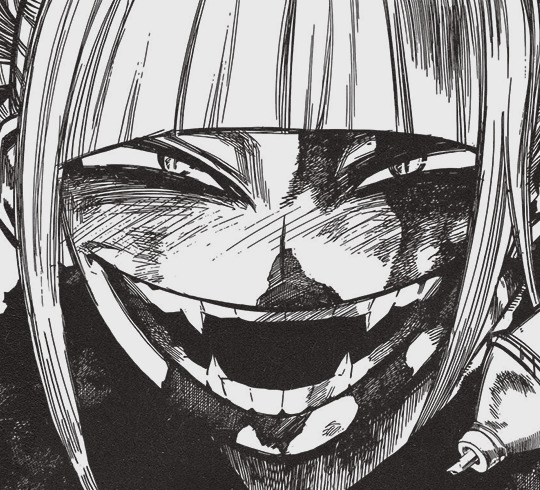
Himiko looks like the most straight forward case of what pop culutre considers to be a classical sociopath / psychopath in My Hero Acadmia. Shigaraki, Dabi, Hawks were all groomed to become the way they were, but Himiko possessed a natural inclination towards blood and violence from the start. She seesm to be a natural born cold blooded killer, however in this meta I’ll argue that while Toga seems like the flip-side of a normal, good person like Uraraka, she’s actually just a normal girl herself.
1. Character Origins
Volume sixteen of My Hero Academia had an official illustration included as an extra that shows the characters Twice and Himiko drawn together in an illusion to a famous Joker and Harley Quinn illustration.
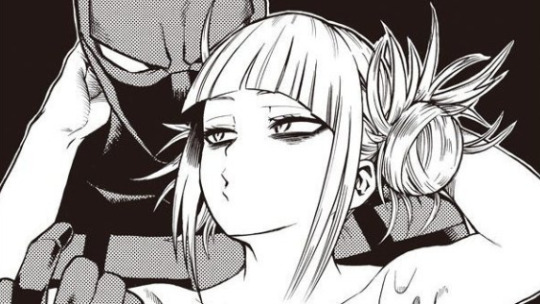
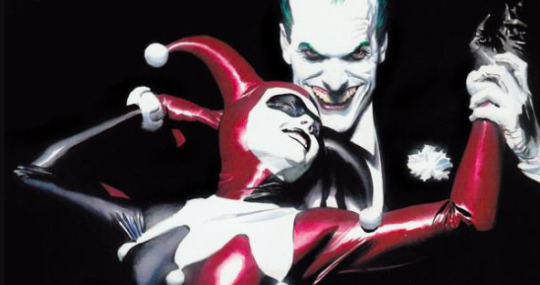
Now, I’m not going so far as to claim Himiko was based off of Harley Quinn, but one the league of villains and characters like Twice (and ReDestro) have made similiar references to the Joker before that especially with the quote “All it takes is one bad day”. There’s also enough similarities betweeen the two characters, they’re both the only female members of a crime syndicate that is mostly men, and dominated by men. Their backstories mirror each other, they were both relatively sane, normal, girls, until suddenly they cracked one day and became a total inversion of their previous presonality. There are enough similarities that I could use Harley as an example to explain a few of the important ideas present in Toga’s character.
They are also both female characters who are written with love as the central concept of their characters. Harley’s origin as originally depicted in the comic and episode for the Batman the Animated Series “Mad Love” goes as follows: Harleen Quinzell was a psychiatrist working at Arkham. Eventualy she came to sympathize with one of her patients which triggered a transformation in her from well meaning doctor, to love-sick sycophant of the joker who broke him out of prison.
A lot of Batman Villains have origins like this. The most comparable one is Harvey Dent. Proescutors, Doctors, we are told the people who hold these jobs are good and righteous people. Even Harley herself started out as someone who just sympathized with a patient too much. However, somehow they become flipped into the exact opposite versions of themselves. They go mad for lack of a better words. Harvey Dent who was once a symbol of justice, becomes nothing more than a murderer, and Harley Quinn goes from healer to the sidekick of a mad clown willing to destroy everything in the name of love.
The question, asked in both Himiko and Harley’s stories is how can good people flip like this?
Most people have a black and white view of these issues: good people are only capable of good actions, and bad people are capable of bad actions. It’s hard to swallow the fact that any normal person has the capacity to cause so much harm inside of them.
We see similiar remarks in the background of Himiko’s story. Himiko comes from a good upper class family, she went to what was most likely a good school, she was always smiling and surrounded by friends. Everyone who comments on her sudden transformation reacts in a similiar way. “She was aways so cheerful and well-behaved, I still find it hard to believe.” She was always such a good girl, and good people don’t do those things.

Normal people, good people, don’t have the capacity to do bad. That’s what makes the transformations so shocking. Therapists/Doctors are supposed to heal, Prosecutors are supposed to be just. And now we return to our old friend Jung.
The story of Harleen Quinzell and Harley Quinn. The story of Himiko Toga the happy middle school girl and Himiko Toga the serial killer is a tale told over and over again, it’s just usually told with male protagonists instead of female ones. It’s Dr. Jekyll and Mr. Hyde.
Robert Louis Stevenson’s The Strange Case of Dr Jekyll and Mr Hyde (1886) is a late-Victorian variation on ideas first raised in Mary Shelley’s Frankenstein (1818). Stevenson’s monster, however, is not artificially created from stitched-together body parts, but rather emerges fully formed from the dark side of the human personality. In the story Dr Jekyll, an admired member of the professional Victorian middle-classes, conducts a series of scientific experiments which unleash from his own psyche the ‘bestial’ and ‘ape-like’ Mr Hyde (ch. 10). Gothic fiction had examined the idea of the sinister alter ego or double before on many occasions but Stevenson’s genius with Jekyll and Hyde was to show the dual nature not only of one man but also of society in general.
“Man is not one, but truly two.”
Robert Louis Stevenson
Both cases are tales are transformation, of the monster coming from within. Himiko transforms from middle school girl into serial killer. Harleen Quinzell transforms into Harley Quinn. Dr. Jekyll becomes Mr. Hyde. We witness a transformation into a monster that seems the antithesis of everything that person was boefre, but was inside of them all along this works because of the jungian idea of the shadow.
The shadow is the unconscious side of personality. The shadow is what exists but what we do not acknowledge. If our behavior during everyday life, choosing to smile, choosing to talk to people, choosing to use our manners is a mask then the shadow is the face beyond the mask. The conscious personality conceals, the shadow reveals. It’s the difference betewen who we are and who we choose to be. The shadow isn’t necessarily negative however. The shadow is just the repressed side of our personalities, it’s what we try to hide.
The shadow plays a role in Harleen’s transformation. While it’s present in Mad Love as well, a recent miniseries ‘Harleen’ really dives into the Jungian symbolism. There’s even several similarities in common with Himiko’s story, for example there’s a scene where Harleen is shown watching the bat man beat up joker and notice how everyone is cheering despite the fact that it’s violent.


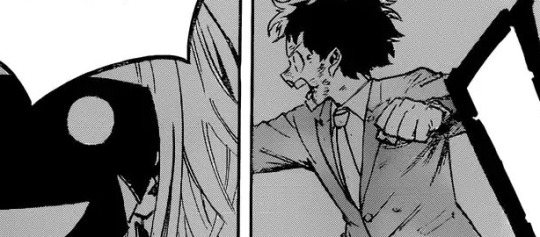
Himiko’s interest in a boy is sparked by watching him get into a fight while everybody else is cheering for him.
The cover page depicts the change between Quinn and Quinnzel as a crumbling mask, which is the exact same imagery used for Himiko.
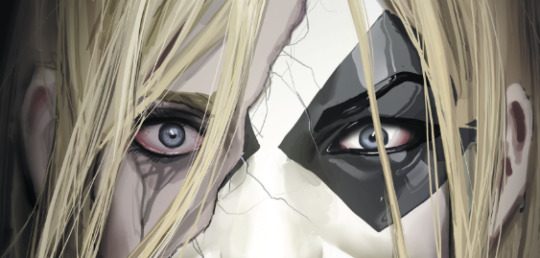

When she enters Arkham she chooses to depict Harley Quinn’s silhouette in Harleen’s shadow. Once again implying that the transformation is not so sudden and jarring as it seems, that Harley Quinn has always been there and is a part of her psychology the same way Mr. Hyde is inside Dr. Jekyll.
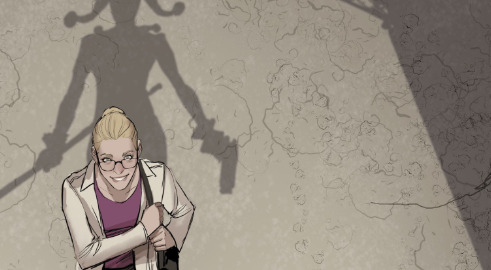
The comic even points it out. Harleen, and also by extension Harvey Dent are people who claim to be “good, righteous people’ and yet both of them end up transforming into murderers. Two-face’s name is literally two-face.

There’s also one particularly Jungian sequence in the middle of the conflict. She dreams (dreams are unconscious and therefore the realm of the shadow in Jung’s theories) about the city of gotham as a place inhabited with citizens who are monsters wearing the faces of human beings.
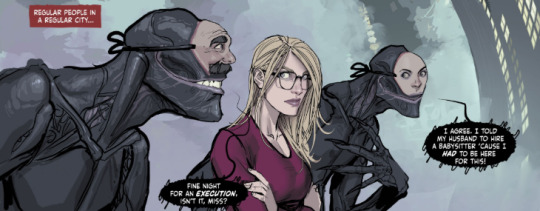
The idea is consistent throughout that Harleen is not really a ‘good person’ she’s merely repressed. She has had this capacity to be violent inside of her, this selfishness, all of these dark desires carried with her all along but rather than deal with them in any healthy way she repressed them until repressing them is no longer an option. Harvey Dent’s face gets half burned off, Harley’s skinn gets bleached by chemicals, the monsterous features inside of them are now worn on their faces and they have to wear their ugliness on the outside rather than the inside. They are now expressing every single thing they have repressed. However, the suggestion in both stories is that these are not special cases, that Gotham is such a repressed society that everyone is repressing the things they don’t like about themselves in that way. Harley fell in mad love sure, but love was just the reason, just the trigger, the truth is those feelings always lurked inside of her and she had no healthy way of dealing with them before that point.
That is the shadow, it’s everything you repress but it never disappears. If you ignore it, it takes on a life of its own. In some cases, like Harley’s you basically become your own shadow. Harley is the flipped upside down version of Harleen Quinzel, now her inner demons are what are expressed on the surface (desperation to be loved, violence, etc.) while her ‘normal’ self is hidden under a mask of insanity. That’s in fact how she ends the comic, Harley qalking around while Harley is trapped on the other side of the mirror because they have basically traded places. Now Mr. Hyde is walking around, while Dr. Jekyll is hidden personality. But it’s important to remember it’s not something like a split personality, Harleen Quinzell and Harley Quinn were always two sides of the same person. Even when she starts expressing her ‘bad’ traits, the good traits don’t go away. They’re just hidden underneath the surface the way the repressed bad traits used to be. Because you’re not good or bad, you’re not one side or the other. You’re both at the same time. Man is not one, but truly two.
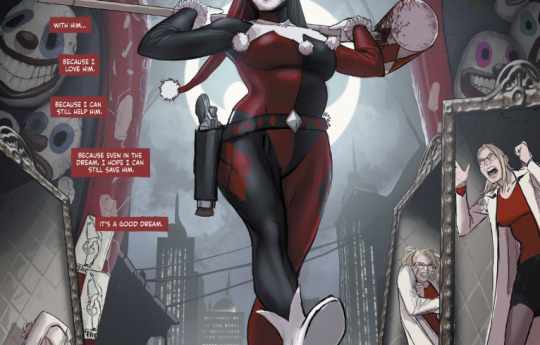
So the complexity in Himiko comes from understanding that she’s BOTH a normal girl, and also a blood crazy yandere psycho.
2. A Normal Girl - Uraraka Ochaco
Uraraka is a pretty standard shonen heroine. She’s a cheerful girl. She’s a supportive friend. She’s the embodiment of what you’d call a good, kind, person and doesn’t seem to be any more complex than that. She lacks say the drive to be a hero that Midoriya does, the superiority complex that Bakugo has, the emotional issues that Todoroki has. She seems to always be agreeable and in a cheerful mood.
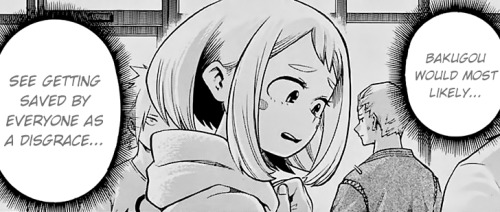
If you look just a little bit closer though she always seems to be walking on eggshells when she’s around others. She doesn’t want to join Deku and the others to try to save Bakugo from the heroes because, it might hurt Bakugo’s feelings.
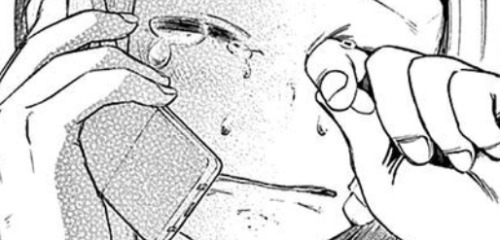
When she loses in the hero tournament, she apologizes to her parents crying not because she feels bad that she lost, but she feels like she failed them. Like it was her job to win and bring money home. However, when Deku comes to check on her in the room she’s already completely hidden her tears.

Going into her backstory we learn that Uraraka is walking on eggshells around everybody due to her own parents, that she’s spent her life trying to be as small of a burden on them as possible because she could see the tired looks on their faces. She’s a child who felt guilty that her parents had to take care of her.
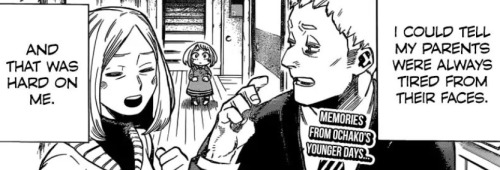
So, for Uraraka her entire life is devoted to making herself seem as small and inconsequential as possible. Other people’s needs will always trump hers. Other people will always have more noble motivations for becoming a hero than she has. Other people’s emotions will always be louder and take priority over hers. Uraraka sees her own emotions and needs as mere trifles that get in the way, and so she always shuts them down. We see Uraraka as a version of Himiko, a high school girl who always appears to be cheerful and well-behaved but is merely repressed.

Uraraka repeats the same unhealthy behavior as Himiko once did. Which is why Uraraka’s first meeting with Himiko goes with Himiko getting such a cold read on her.
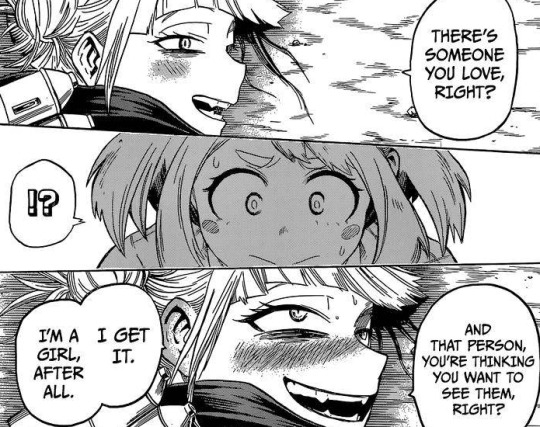
It’s helpful to view Himiko as the flipped version of Uraraka. Uraraka hides everything that’s pleasant about her on the inside, and on the outside appears like a perfectly selfless girl. Himiko is someone who hides her good qualities and instead wears the mask of a bloodthirsty psycho on the outside. While Uraraka lives by denying her selfish desires, Himiko always chases after them and is true to them.
Traits that are repressed in Uraraka, are expressed in Himiko. Especially traits that society sees as bad in girls, like selfishness, being emotional, etc..
The way Himiko acts is especially jarring because she seems convinced she’s a normal person. She’s in her own little world, making friends, getting along with other people, it’s just her friendship just happens to involve stabbing.
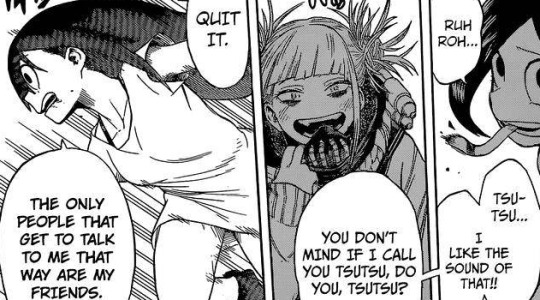


Himiko appears to be a girl psychotically obsessed with blood and nothing else. A girl who only cares about killing other people and chopping them up to bits. When she expresses the feelings deep inside of herself, literally no one can make heads or tails of what she’s saying, she doesn’t sound like a girl just a bloodthirsty monster.


While Uraraka seems like she has nothing in common with what is essentially a weird serial killer, we learn that the exact behavior that Uraraka’s creation is what led to Himiko’s current state of mind.
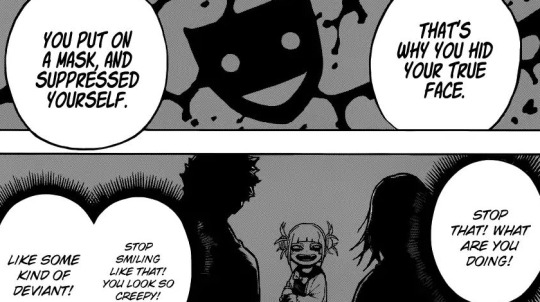
The difference between them is not that Uraraka is a person of higher moral character, or a better person, but rather of circumstances between the two of them. It’s not the choices they made but rather things they were born into and couldn’t control. Uraraka has parents that accept her even when she fails and encourage her.
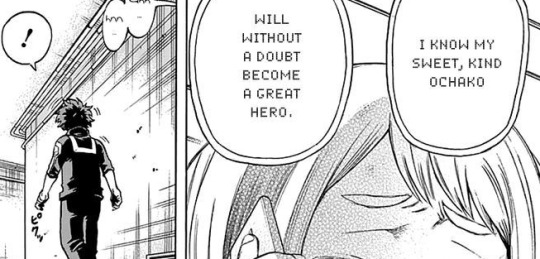
Toga had parents that abused their daughter, and then abandoned her.


Uraraka chose to repress herself, while Toga was forced to become repressed by her parents. While we don’t know for sure if it was physical abuse it’s at least emotional abuse, and it had to be to an extreme extent to make Himiko snap that hard. The same unhealthy behavior but push to extremes gets extreme results.
3. Normal Girl - Himiko Toga
Himiko did not become the way she is because she was lacking empathy or born with uncontrollable urges for bloodlust, but because of the environment around her that always forced her to repress herself. From the knowledge that her parents would never love her for who she really was. Himiko wasn’t born that way she was a response of what was done to her.

People who don’t really know Himiko always judge her this way, that she’s incapable of understanding other people, that she has no empathy for others. She’s almost literally labelled and dismissed as a one dimmensional yandere trope by the people surrounding her.
However, Himiko is in fact always doing the opposite. She’s constantly trying to empathize with others. Her maddened way of talking to both Tsuyu and Uraraka in her character introduction is exactly that, her trying to feel that kind of connection.
Himiko’s fascination for Uraraka is a desire for empathy and understanding. One that you could say even surpasses some characters on the hero’s side, because she’s willing to try to understand the world’s of people who are nothing like her. Himiko’s next most significant action in the manga is to take Camie’s place and go after the kids. While she does fight against them she’s not overly violent, just curious. Deku even reaffirms some of Himiko’s primary traits.

Himiko is always talking a lot and trying to explain her way of thinking to other people, because she wants them to understand her. However, because she’s bad at communicating this tends to come off as babble and a lot of people completely dismiss what she says and don’t attempt to listen.

She expresses two things one a desire to know Deku on a deeper level, immediately asking him very personal, and sometimes very downright invasive question and two she also notices the closeness that Deku and Uraraka have for one another.

Once again this is a repeating theme for the league. Himiko repeats the same desire that Twice has, to become a person who is trusted in the same way.

Once again it’s important to remember that Himiko is just the flipped version of a normal girl. If most people hide their bloodlust and show their good sides, Himiko hides her desire to be trusted and to empathize with other people underneath her bloodthirsty urges she shows on the surface. She positions herself as a femme fatalle, but she’s actually just a girl who’s trying to understand why other people are different then her, and why Deku and Uraraka can have a relationship mutually founded on trust when she can’t.
Himiko’s past was so repressed she never formed real relationships with people. Not only that she assumes that nobody will want the real her, because the moment she flipped and the real her was exposed everybody in her life abandoned her and she had to run away.
After her brush with Deku and Uraraka we see Himiko start to be trusted by her comrades and a marked transformation takes place in her.

We see shades of the old Himiko. A selfish girl who only exists to fulfill her whims. However, we’re shown Himiko is capable of empathizing because not only do Shigaraki’s words get through to her.
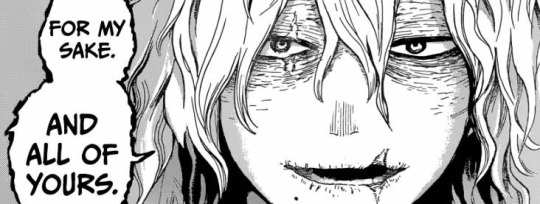
Himiko is also for the first time able to reach the emotions of another person. Remember when Himiko tries to explain how she’s feeling, she babbles, and babbles and nobody listens. However that changes and for the first time, not only does Himiko pick up exactly on what’s troubling Twice, she also comforts him the way he needs to be comforted. She tells him that yes it might be his fault that Magne died, but she sees that he’s doing his best to make up for it and she gently encourages him.
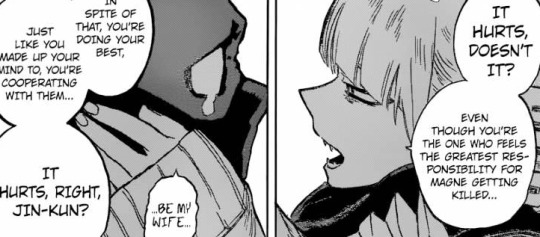
Remember how important this is for Twice. The world has never forgiven Jin for his mistakes. He hit the wrong guy on accident, while obeying the law, and lost both his job and his home. He started stealing to make ends meet, and as a result he lost his mind. When he makes a mistake it always blows up in his face but this time, Himiko notices that she’s panicking and comforts him telling him it’s okay he’s made this mistake and he can still work hard to fix it.

Not only that but she notices what the problem was with Jin, she was able to notice the symptoms of his psychotic breakdown and rather than dismiss it as just Twice being crazy was able to help him in real tangible ways by wrapping her hanky around him and covering him up like he asked. Uraraka has a very surface level kindness, she’s kind but only by walking around on eggshells with everyone. Himiko is able to see through people, but uses that to comfort people on a deeper level.
The “Himiko just can’t control herself because of her quirk” narrative is something that Himiko rejects herself. Because that’s not what Himiko wants. Himiko doesn’t want to be special or different from other people.
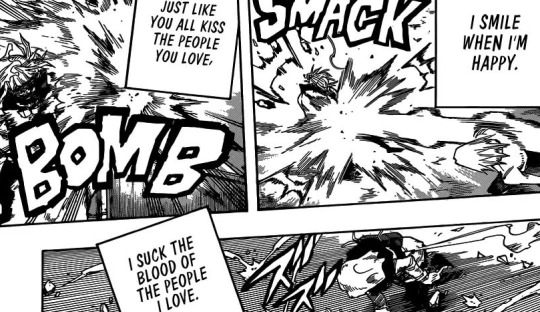
Himiko sees herself as normal, and what she desires to be understand and be understood by other people. She doesn’t like Curious’ narrative for her because it made her out to be a freak or someone special when Himiko is trying her best to get others to understand her as a normal girl. Himiko can’t repress herself anymore, she can’t become normal the way her parents taught her too so not permanently broken, and forced to always express herself she’s trying some other way.

What she wants isn’t to hurt other people, not really though. Those thoughts just turn violence, because Himiko is herself a person who’s endured a lot of violence. Himiko is basically a child that’s been on her own living on the streets and surviving for years, with all the dangers that entails, and also people who can shoot lasers and punch things really hard chasing after her.

The more she’s isolated and on the run, the more violence she endures, the more violent and unhinged her thoughts become. The more she’s exposed to people who accept her for who she is, the more she’s trusted by those people, the more empathic and sensitive Himiko becomes instead. Himiko’s desire isn’t violence, when she’s pushed to her utter limit she says what she wants is to become a girl like Uraraka who is just loved and trusted by others for who she is.
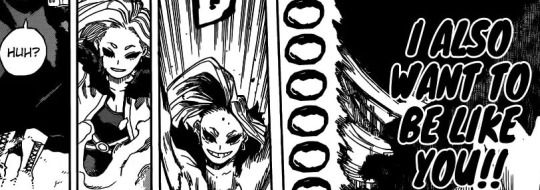

And I genuinely believe at the core of Himiko’s character this empathic girl exists. Himiko becoming violent and unrepressed doesn’t mean her empathy disappears. The complexity from Himiko is that she’s both the knife wielding psycho and the normal girl who just wants to have friends at the same time. If behind every normal person there’s a monster lurking is true then the opposite is true as well, behind every monster there’s a normal person.
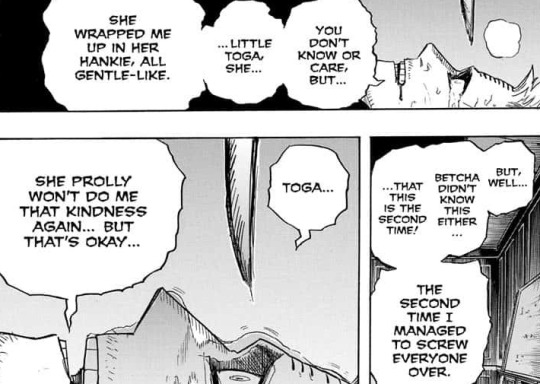
This is an idea expressed by Twice again. One of the villains that Hawks dismissed as a bad person, was capable of showing him compassion and gentleness even when he screwed up. Toga was capable of empathy for Twice besides the use he had for others. Toga herself is shown to be capable of more empathy than Hawks, who is one of the most selfless characters in the series, and who is convinced his actions are always done in order to save others.
However we see their treatment of Twice is so drastically different. Hawks treats Twice in a selfish way refusing to listen to what Twice wants, and only ever used Twice as a tool to exploit. Twice himself thinks that now that he’s no longer useful, Himiko won’t be kind to him anymore however we see the opposite.

Twice admits to Toga that he’s the reason that everyone is in danger right now and he completely failed, and he’s not going to come save them. He admits that he’s useless and Twice himself said Toga wouldn’t be kind to him anymore. However in that moment, Himiko ignores the fact that her life is literally in danger and everything is going to hell around her to comfort Twice one final time and tell him the words he needs to hear.
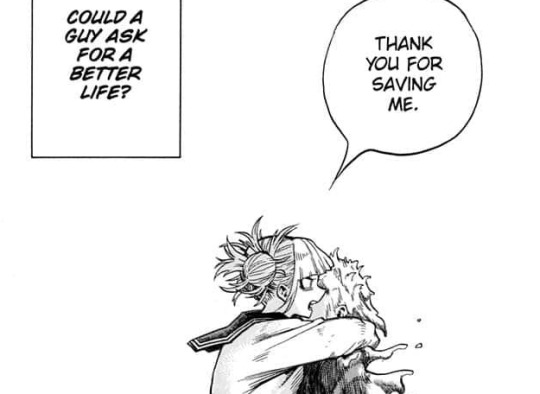
It’s literally the single most empathic moment of the manga, and it’s in direct contrast to Hawks’ behavior. A hero as devoted to saving other people as Hawks, who genuinely likes Twice as a friend doesn’t show him any empathy at all and even stabs him as the back. A psycho like Toga puts her own feelings aside and notices Twice’s feelings, and gives him comfort and thanks him in his final moment because to her Twice has value as a person beyond what his use is. That Himiko is capable of this kindness, but equally capable of her monstrous actions earlier in the series is what makes her human. Her kindness doesn’t make her any less mosntrous, and her monstrous qualities don’t make her kindness go away she’s both at once, rather than either or. That’s where the complexity comes in.
Toga is a very human character precisely because we see her at her most monstrous, and we see that girl slowly relearn how to express the kindness that’s always been inside of her in healthier non-stabby way. A normal girl who learned how to be a monster to protect herself. A monster who is slowly relearning to be a normal girl.
#himiko toga#jin bubaigawara#league of villains#league of villains meta#league of villains friendship#mha meta#my hero academia#my hero academia meta#my hero academia villains
632 notes
·
View notes
Text
Is Scoopshipping Good Writing? An Extremely Long Text Post
This is partially a response post to criticism of the ship and Jack’s development in the Dark Signers arc, and partially my own analysis of Jack and Carly’s relationship--specifically whether it is congruous with Jack’s Fortune Cup characterization and whether it says anything meaningful besides just invoking the Power of Love.
Introduction
It’s been over 10 years since 5D’s first aired, which is surreal. I still remember thinking the whole concept was ludicrous at first, but it eventually became my favorite Yugioh series (though I usually ignore the series post-episode 64 and consider the first 64 episodes by themselves). It was really primarily because of these two fools that I started watching in earnest:
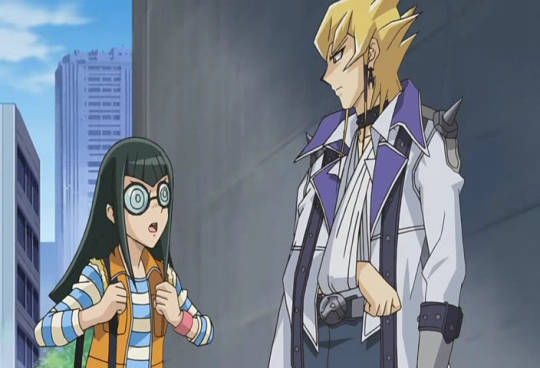
I shipped them big time. Even now, I still really adore their relationship. Most of my ships I end up becoming less obsessed with over time, but Jack/Carly continues even to this day to captivate my heart and imagination.
Recently, though, I’ve been thinking about the question, is their relationship good writing? Especially in how consistent it is with Jack’s characterization in the Fortune Cup arc, and whether or not it works to develop him as a character afterward.
(Of course, my personal stakes in the question is, should I be shipping them? While ships obviously don’t have to be well-written in canon or anything like that for someone to ship them, it’s significant to me because so much of the reason I liked Jack/Carly in the past is because it did feel decent character development, especially in contrast to what came after the Dark Signers arc.)
Why I’m Writing This
This sense of doubt about the writing of their relationship is especially spurred on by this character analysis of Jack:
“A lot of people seem to think that the introduction of Carly and the whole romancey subplot developed Jack as a character and for the better. I could not disagree more. If there's one word I'd associate with Jack prior to his entire development and dignity as a character going down the crapper, I'd have to say it's 'ego'. How did Rex/Jaeger get him to sell out his friends, steal Yusei's stuff and join him? He appealed to Jack's ego. How did he persuade him to stay after his first loss to Yusei? By telling him about the signer and reassuring him, again, that he was special. Overall, Jack just struck me as a very focused and driven character, intent on achieving his own goals on his own. He actively pushed away everyone who tried to get close to him, most obviously Mikage, who is consistently worrying over him but whom he never spares as much as a thought or a kind word for in return. Ever. This egocentric attitude is also, at the risk of over-analyzing, consistent with Red Dragon Archfiend, both in its moving away every defensive obstacle in its way and in its actively destroying any monsters that didn't join it in attacking. I generally don't like going onto this level of symbolism because it so easily devolves into semantic nonsense, but given the parallels here and the similarly fitting effects of Yusei's Stardust, I thought it worth mentioning. This would also lend a bit of further significance to him handing the card over to Yusei before the tournament, not only affirming his egocentric wish to beat Yusei at his strongest (and thus redeem himself for their last duel) but also his rejection of the self-sacrificing/others first mentality that the card represents. His obsession with Red Dragon Archfiend after that duel is also consistent with this interpretation, with Jack pushing himself even harder to prove to himself that his way is correct.
“Overall, I don't object to the notion of Jack learning to be less ego-centric as development, but the way the dark signer arc handled it was beyond contrived and ham-fisted, pushing him into an impromptu romance that was completely inconsistent with egocentric personality thus far and completely glossing over the far more interesting questions of how he'd rebuild his ego after essentially losing his entire self-image as the king in front of everyone. Instead, apparently all he needed was for a crazy lady to abduct him from hospital, blackmail him for the sake of her own career, then give a few lines of generic encouragement and invoke the power of love. From where I'm standing, it was obvious that he was intended to be Yusei's main foil, representing a pragmatic, egocentric worldview to contrast with his idealistic views on bonds and friendship, but equally clear that that idea was quickly scrapped in favor of shipping bait and deifying Yusei.
“Jack Atlus, he deserved a far better closure to his development than Stockholm syndrome.” --Aea (http://neoarkcradle.net/forum/showthread.php?tid=26&pid=735)
Before I get to what I think is actually pretty solid about this analysis, I want to address some points. The idea of Carly being “crazy” is pretty hyperbolic. Calling what she did “abduct[ion]” is just inaccurate--after all, Jack asks her to take him out of the hospital, and he also refuses to return when Mikage and Ushio go to get him. Of course, he tries to leave her place in episode 31, but he also seems to willingly return there at the end of the episode. Because she wasn’t really kidnapping him or holding him at her home against his will, their relationship isn’t Stockholm syndrome.
I do think there’s some validity to the idea of her blackmailing him for her career. She does try to draw attention to him when they’re out in public in episode 31 in order to get him to stick around so that she can get a scoop from him. As comically as it is presented in the episode, that’s nonetheless what she does (and she also tries to leverage his lack of gratitude, too!). But she does ultimately feels remorse for that and resolves to not write any article that would hurt a duelist (even despite the fact that Jack lets her write what she wants about him), which is glossed over in this analysis of Jack.
I also don’t think that the encouragement she gave Jack was super original. Here’s the exact quote (which she says in response to Jack divulging his past to her):
“If you get the picture that much, why don’t you just start your life over again? The old Jack died in that battle with Yusei. Now it’s time for the real Jack Atlas to live. Plus, it’d help you in becoming a real King, right?”
Essentially, she tells him that he can get back up again after his loss and be even better than he was before. Yeah, at face value, it is pretty generic. But I do think that it does speak into a lot of what he was struggling with, at least as it is depicted after his defeat. Now, whether these are things that make sense for him to struggle with is a different issue that I’ll discuss in a later section.
And finally, I do think that Jack/Carly invokes the power of love trope. At least, Jack invokes it himself when he is talking back to Godwin in episode 63: “No matter how much I deny it, I cannot escape from what’s known as ‘bonds.’ And what helped me understand that was one woman’s love!” I don’t think the power of love is necessarily a bad thing, and I think it makes sense for someone who gave up their bonds from the past to pursue his own goal to be able to be moved and changed by someone genuinely caring for them.
Now, whether or not it was a good decision to have love be the driving force in Jack’s character development during the Dark Signers arc is a different question, which brings me to the points of Aea’s analysis that I find really compelling and want to grapple with.
What I read Aea as primarily saying is that Jack in the Fortune Cup arc is depicted as a highly egocentric person, and that his plotline with Carly in the Dark Signers arc is a) inconsistent with that previous characterization and b) not as interesting as a plotline in which his egocentrism could continue to serve as foil to Yusei’s worldview.
I think a lot of that makes sense. I do think Jack was driven by his ego, and I do think that it might’ve been more interesting if his self-driven worldview were able to be given as much validity as Yusei’s idealistic, others-driven worldview, which is ultimately what is privileged. I can also see how Jack being primarily motivated by saving Carly during the latter half of the DS arc may be incongruous with his egocentrism just 20 or so episodes before.
At the same time, though, I think there are a lot of directions 5D’s could have gone which have the potential to be more interesting than the one it actually went, so rather than wondering about what could have been, it would be more worthwhile to examine Jack/Carly’s plotline and see whether or not it is inconsistent with Jack’s previous characterization, and also to see if it has any merit of its own as far as it develops Jack’s character.
Particularly, I am going to argue that a) although perhaps not as well executed as it could be, it made sense for Jack’s character to need to change after the Fortune Cup arc, and the way it changes is not incongruous with his previous characterization. Indeed, Jack’s character development in the Dark Signers arc centers around him reconceptualizing what being a King is.
Also, b) Jack and Carly’s relationship ultimately deals with and says interesting things about the idea of being driven by oneself that, rather than totally undermining the mentality that initially drove Jack to abandon his friends to become King, gives it some nuance.
Point A: It made sense for Jack’s character to need to change after the Fortune Cup arc, and the way it changes is not incongruous with his previous characterization. Indeed, Jack’s character development in the Dark Signers arc centers around him reconceptualizing what being a King is.
So throughout the course of one arc, Jack goes from being a man who is motivated primarily by himself and his desires (to the point of being willing to put down others for them), to a man whose main reason for action is someone else’s well being. It does seem like a stark change. Rewatching the Jack/Carly duel, the sheer amount of concern for Carly that Jack shows is pretty astounding.
But I think that it’s understandable for there to need to be a change. For one, the particular reason why Jack lost to Yusei in episode 26 in the first place is because he tried to win using the same strategy as before--he wanted to redeem himself for his first near loss. Clearly there is a need for a change: Jack loses not once but twice to Yusei in the same season, and Yusei also cites Jack’s pride as a King as his reason for his loss.
The drama between Yusei and Jack during the Fortune Cup arc is driven by Jack losing to Yusei and needing to duel and beat him again to redeem himself and prove he’s the better duelist--that he truly deserves the title of King. In episode 6, when Jack realizes he would have lost to Yusei, it’s clear that he’s not driven by how his fans perceive him. While his fans have no idea that he lost, he’s nonetheless still bothered because he, the King, knows. In episode 8, Jack feels like he’s not the King anymore, even though Mikage says he still seems like one. The cheers of his fans sound hollow because he knows he doesn’t deserve them.
Something I find interesting is Jack’s awareness of his counterfeit Kingship revealed through his calling himself a clown. After his initial defeat, Jack asks Mikage if he’s a clown in episode 8, in episode 25 he asks Godwin to release Rally and co as “reward for a clown,” and in episode 31, he also uses the language of a clown when he talks to Carly: “Back then, I gave up everything, and what I gained from it was the path to being a King who continually acts like a clown as he lies about his true identity.”
Because of this, the way I see Jack’s character is that his identity as the King was made counterfeit at almost the very beginning of the series (episode 5). He then spends the entire rest of the Fortune Cup arc trying to regain his original conception of his King identity, only to ultimately fail. From Jack’s own language, I think we’re meant to see this as Jack’s foolishness. While it may have seemed fine for two years, the King identity that he had held onto no longer worked for him. When confronted by someone from his past, his King identity starts to crumble--first he’s defeated not once but twice, then it’s revealed he’s actually from Satellite, etc. In episode 25, he even shows awareness that Godwin baited him with the idea of being a duel king; when Godwin asks if that isn’t what he wanted, Jack says that he wanted to rule as “the King [he] truly desired to be.” Indeed, it’s revealed that he wasn’t even valued by Godwin for himself, but rather as a means of getting to Yusei. It makes sense, then, that his development after his defeat should center around letting go of his original conception of his King identity and discovering something more true.
All of these realizations are those that Jack comes to more or less on his own; Carly even says that Jack already “get[s] the picture.” So I do think it is congruous with Jack’s Fortune Cup characterization for him to need to find a new way of being King in the Dark Signers arc. Hence the need to start over, as Carly suggests. (And which is revisited in episode 37 when Jack talks to Mikage again, episode 59 when Carly does her fortune telling stuff, etc.)
I think it’s because Carly gives him hope after he loses his King identity that she makes such a mark on him and effectively becomes his main motivation in the DS arc. And I mean, Jack in the DS arc is still pretty aloof and pushes others away—he makes it clear to Yusei that he “hasn’t become anyone’s friend” in episode 45, and he really doesn’t rely on anyone else even as he angsts over Carly. No one even knows the identity of the Dark Signer he’s fighting. While Yusei still draws on his friends for strength, we see Jack continue his independent streak. Heck, he even pushes Carly away! (And she honestly probably would have been better off and not have gotten killed if she had just stuck with him, but that’s for another AU...)
An aside - I sometimes read people saying that they think Mikage could have filled the same role Carly did. Maybe, if written differently, she could have. But I think it’s notable that when Jack is angsting about having lost his sense of being a King in episode 8, Mikage is not really able to understand or speak to him in a way that actually meets him where he is. She clearly cares about him, but I think she’s not able to get past the image of the King that she and his fans project on him. I think Carly is able to empathize with his pain more. When Jack calls himself foolish and a clown, Carly doesn’t try to convince him he’s wrong--instead, she says something more like, “Sure, that’s true--but that doesn’t have to still be who you are.”
Point B: Jack and Carly’s relationship ultimately deals with and says interesting things about the idea of being driven by oneself that, rather than totally undermining the mentality that initially drove Jack to abandon his friends to become King, gives it some nuance.
I would argue that this is because Carly’s own character, as well as their relationship in general, deals a lot with themes of selfishness. While not presented as starkly as Jack’s self-drive is, it is obvious that Carly is someone who is self-driven and desires to achieve her goals, not completely unlike Jack. Her first appearance has her going past a swath of reporters to talk to Godwin, and her subsequent interaction with her boss shows that her job is precarious and that the scoops she seeks after are at least in part to keep her job. Like Jack, she came from a lower class background (although “the streets” rather than Satellite), and she doesn’t seem to have any close ties (Angela the reporter might count, but that’s a stretch). And when she goes to talk with Yusei and Dick Pitt after their duel, her concern is not with their wellbeing but about getting information from them for a scoop. “Straight ahead is the only way for me,” is something she repeats, showing that she knows where she wants to go and is determined to get there.
Indeed, Carly would not have met Jack at all if she had not snuck into the hospital trying to learn if he was truly from Satellite. She is someone who is driven primarily by herself, albeit more innocuously than Jack is. This also underlies why she was willing to “blackmail” Jack into going to the amusement park with her. She needs a scoop and is ready to do what it takes to get it.
But, we see how in the same episode, she starts thinking less of herself and more about another--Jack. She thinks, “He’s really hurting inside. And here am I trying to write an article about it. Am I a bad person for that?” She considers what he is going through, rather than just her own needs. When she defends Jack to Angela, she is driven not by her desire to keep Angela from getting her scoop, but a genuine care for Jack. And when she figures out he’s going to the tower to look at Satellite, it’s only by inhabiting his point of view and thinking about what he may want. Yet the question she asks herself--whether or not it’s bad to be writing a scoop about him (after all, it is her job, as Angela points out)--is an important one for her.
As self-driven as Carly is, she realizes she has limits--that is, she would not go as far as to hurt another person to achieve her own goals. Jack, on the other hand, has already done that, putting Rally in peril and taking Yusei’s card in order to get to Neo Domino City and become King.
We see again how Carly can be self-driven when she tries to get closer to Jack after he leaves, and when it is ultimately an illusion of happiness with Jack that causes her to fall back into her Dark Signer persona. Yet even then, it is clear that she does not want to hurt anyone, and Jack repeatedly reiterates this.
This culminates in the conversation she has with Jack before she dies: Carly: I loved cheering people on who tried their hardest like you, Jack. Despite that, because I tried to wish for such selfish happiness, I must’ve been wrong for doing so, huh? Jack: That’s nonsense! Everyone has the right to wish for happiness. If you’re saying that’s a crime, then I’m just as guilty!
Carly says herself that she was motivated by her own desires. Jack, in affirming her desire to obtain happiness, also affirms the ambition that drove him to abandon his friends. However, we see in how Carly is reluctant to hurt others that while it is not bad to want to pursue one’s goals and happiness, it is important to consider the impact on other people. It wasn’t bad for Carly to want to be with Jack, but it would obviously be bad for that to necessitate the deaths of many; it’s not bad for her to want to write a successful story, but it’s bad for her to take advantage of duelists’ like Jack’s pain to tell that story. This allows us to view the Jack in the FC arc in a new light: his desire to escape Satellite and become a King wasn’t bad, but it wasn’t right of him to harm others in order to get there.
Ultimately, Jack and Carly’s relationship is about two people learning how to pursue their happiness and also learning to put each other’s happiness first.
#jack atlas#carly nagisa#scoopshipping#meta#yugioh 5d's#i have way too many thoughts about this card game anime#retributionshipping#carly carmine#yugioh#otp: you can't even ride the monorail
59 notes
·
View notes
Text
The Walking Dead, “Days Gone Bye” | Analysis
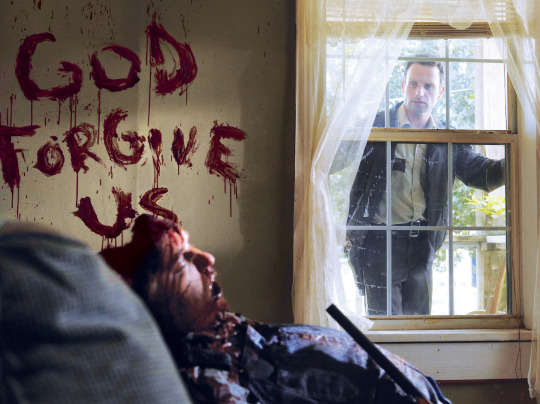
The final season of The Walking Dead comes in August, so I decided to rewatch the show from the beginning as the end is nigh. TWD has been a part of me since I started to watch TV series, and I’ve watched Days Gone Bye more than seven times, so this is certainly one of the pieces of audiovisual media that I’ve consumed the most. To add a new interesting layer in my rewatches, I’ve decided to see the episodes with a critical and analytical lens, seeing it more than just as a pastime, and write my thoughts here. This will be a great ride for me, and I can’t wait to see again some iconic moments from TWD throughout the seasons and write about them.
Part 1: The World Before
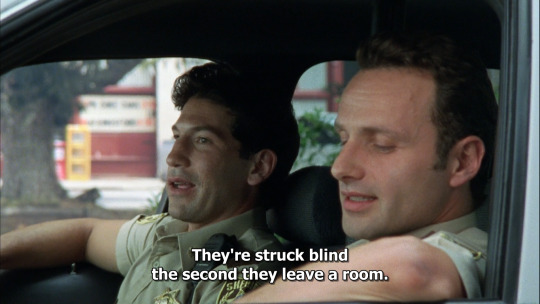
Before getting into the first act of the episode, let me talk about the teaser – the first five minutes of the episode – quickly. As this is our introduction to the world of TWD, Days Gone Bye couldn’t simply start with Rick and Shane having a chat. So it was necessary that the teaser served as a way to establish both the tone and setting of this story, and it certainly does. The teaser tells us that what we are watching is a gritty survival horror story that takes place in a post-apocalyptic world, and the teaser establishes this perfectly without no more than two lines of dialogue. It is established visually: Rick stops his car on a deserted road with no traces of civilization anywhere, then goes to an abandoned gas station where other cars are – and those cars have dead bodies inside. From there, we know right from the start that this isn’t the world we live in. When Rick sees the young girl that is in fact a walker, it is established that this is a world where the main threat are zombies. At least for some part, as in future episodes the series will show us something far more scarier than walking cannibal dead bodies is the real danger.
Now storytelling-wise, TWD already proved its value in the first five minutes. Frank Darabont directed the episode and wrote the script, and his work in the episode both as director and writter is fantastic and set the bar high if the series wanted to have a consistency of greatness in its episodes. After the perfect five minutes purely composed of visual storytelling, the first scene of the first act is dialogue-heavy and character-driven. One would think that it is to establish to us that Rick and Shane are friends, that Rick has a wife and son and that they are cop buddies, and one would be right, but it is also more than simply introduction and exposition, and that’s the beauty of the audiovisual medium as a whole.
Reading books about screenplay writing, I’ve come to know more about subtext and its applications in both movies and series. Despite this first scene doing great work in introducing us to the two main characters of the season – their mindset, persona and some backstory – it also adds so much worldbuilding-wise. Shane goes on his rant about women not switching off the lights in a house before leaving it, and Rick talks about a discussion he and Lori had earlier. See, the teaser showed us a decaying world with walking bodies. Now, the first minutes of act one show us a world where people worry about such trivialities: switching off the lights. In the tagline for the first volume of the comic book, it reads “The world we knew is gone. The world of commerce and frivolous necessity has been replaced by a world of survival and responsibility“. The scene I mentioned is basically the live-action adaptation of it. We see the world of commerce and frivolous necessity in this introduction so we can understand better and fear the world of survival and responsibility that will come later in the episode. TWD started geniously: it went from visually-driven to dialogue-driven, and after that to visually-driven storytelling, all without losing its verisimilitude and charm.
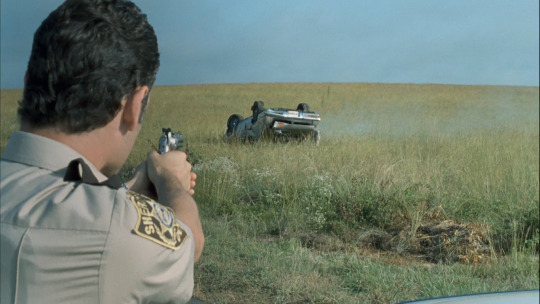
Now, something about the visuals I loved: the grainy aspect. Because this episode was shot on film – in fact, up until season ten all episodes were shot on film – the film grain is obviously visible. But instead of being just an aesthetic choice – shooting in film or digital – I think it’s also meant to have implications tone-wise. The comic books this series adapt is in black-and-white (something unusual in American comics), but it’s because the writer Robert Kirkman wanted the comic to feel like a classic George Romero zombie flick, and it worked completely. Commercially, a black-and-white TV series wouldn’t be much embraced by a large and mainstream public, but I think that Darabont solved that problem and succeeded in maintaining an aesthetic similar to the feel the comic book wanted to transmit. The excessive film grain – something that made me feel like watching a Panos Cosmatos’ movie but without the acid trips – works because it resembles the Romero zombie flicks in color, like Dawn of the Dead. It is a classical and archetypal zombie story – even if it subverts some conventions various times throughout the series – and the visuals tell us that.
Not only that, but the episode has many moments that resembled The Mist in some ways: the camera being close to its characters to make the story feel grounded and experienced by real people, the back shots to make the audience feel like they are following the characters in their journeys, the handhold camera moments that gives a documentary feel, adding a realistic perspective. All that grants a grounded vibe to the episode, which works because this is a story about how people react and live in a lawless world which can kill them at any possible moment without any warnings. It’s where chaos and anarchy reigns and where death always lurks. A story like that works better when it’s experienced through the eyes of the characters. It’s also best represented in the moment where Rick leaves the hospital and sees the sun for the first time. In the shot, the Sun is blinding us with its shining light, but then there’s a cut, and in the next shot we see only Rick covering his eyes while the blinding sun rays don’t make it to the camera. It’s the switch of subjective to objective perspective, as in the first we see the world with Rick eyes – it’s a man getting out of the dark for the first time in months – and in the second we see the same moment but from outside lens, and it showed us that this a day like any other where the sun doesn’t blind you. Besides, this episode has a low budget sensitivity – not meaning that the quality is subpar, but that it has an authenticity that is extremely convincing. It is that low budget quality that makes the story feel real in a certain way. That is, of course, until the tank in the middle of a city is shown, but even with the realism, it is still tangible, and the story continues to feel realistic in its depiction of a zombie apocalypse in the “real world”.
Not only that, but the episode has many moments that resembled The Mist in some ways: the camera being close to its characters to make the story feel grounded and experienced by real people, the back shots to make the audience feel like they are following the characters in their journeys, the handhold camera moments that gives a documentary feel, adding a realistic perspective. All that grants a grounded vibe to the episode, which works because this is a story about how people react and live in a lawless world which can kill them at any possible moment without any warnings. It’s where chaos and anarchy reigns and where death always lurks. A story like that works better when it’s experienced through the eyes of the characters. It’s also best represented in the moment where Rick leaves the hospital and sees the sun for the first time. In the shot, the Sun is blinding us with its shining light, but then there’s a cut, and in the next shot we see only Rick covering his eyes while the blinding sun rays don’t make it to the camera. It’s the switch of subjective to objective perspective, as in the first we see the world with Rick eyes – it’s a man getting out of the dark for the first time in months – and in the second we see the same moment but from outside lens, and it showed us that this a day like any other where the sun doesn’t blind you. Besides, this episode has a low budget sensitivity – not meaning that the quality is subpar, but that it has an authenticity that is extremely convincing. It is that low budget quality that makes the story feel real in a certain way. That is, of course, until the tank in the middle of a city is shown, but even with the realism, it is still tangible, and the story continues to feel realistic in its depiction of a zombie apocalypse in the “real world”.
The whole sequence of the car chase and the shooting between the cops and the criminals is beautifully conducted by Darabont, who knows his craft remarkably and executes it in a manner like no one else does. The memorable shots, shot by Darabont, immortalize the whole sequence and reach its climax – the gunshot Rick suffers – perfectly in a crescendo that works better here than in the comics, this being an easy task, but still, Darabont managed to do it in an impressive way, totally deserving a bravado status.
Also, something that I also appreciated, and I think it’s overlooked: when the police cruiser where Rick and Shane are passes through a road, we see a single crow eating a roadkill. What do this mean exactly? Animals can’t turn to zombies so one might think this is only a moment with no meaning behind it. But now I interprete it as a symbol. It is meant to represent that society has be decaying long before the dead came to eat the living. It remembers me the first Mad Max, where the world is not in the same level as it appears in Mad Max 2: Road Warrior – a full-on post-apocalyptic society – but it is in its final stages, leaning to barbarism and uncontrollable chaos. The producers of TWD announced an anthology spin-off series named Tales of the Walking Dead, and it certainly would be interesting to see more of the transition between our world and the post-apocalyptic zombie-ridden world, showing the process in-between of transformation and decay.
Part 2: Brave New World
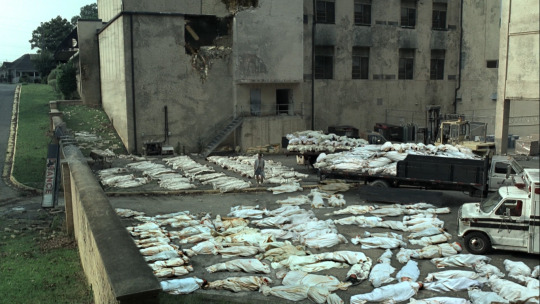
The second act starts as Rick steps out of the hospital and faces the current reality of his world, and it’s an ugly one. Rick sees dead bodies everywhere and discarded military gear. Something dreadful happened when he was in a coma. The world undergone a change so great in his sleep that it’s impressive that Rick didn’t drown in total madness when he first saw what’s left of society. Most of act two is about Rick having to come to terms with his new life: one entirely ruled by survival. Now, another interesting element that is also a symbol in my interpretation: the bicycle girl. The bicycle girl (which is the zombie without its lower body) is the first walker Rick encounters. He is scared by her and runs away from her with the bicycle that was there next to him. The bicycle girl is nothing more than the remains of the past life of Rick and the world before. It is dead and alive at the same time – like the walkers – but in a pitiful state. It can’t be on its feet and is always trying to grasp and touch Rick, but, ultimately, it can’t. Rick fears it, and because of that he runs.
Most of the second act is focused on the interactions of Rick and Morgan Jones. Morgan, after encountering Rick and saving him from a nearby walker, takes him inside his house, but fearing that the gunshot wound was in fact a walker bite, Morgan rightly tied Rick to a bed and waited for him to wake up to ask some questions. Now, it’s incredible how this episode never misses a beat and is not made of only three truly great scenes, but all of the scenes are great. The whole dinamic of Morgan explaining to Rick what happened and what it takes to live in this new world felt so natural that no critic could say it was bad exposition. It was exposition done right, revealing more about Morgan’s character, showing him as a good man and a father to his son Duane. It’s easy to understand why Rick and Morgan liked each other one day after meeting for the first time. The chemistry is real, and it’s unbelievable how seasons later, when they see each other again, the chemistry is still there.
Andrew Lincoln and Lennie James are spectacular actors. Their acting in this episode is astonishingly extraordinary. I’m pissed that they didn’t won any awards for it, they certainly deserve it. Andrew’s acting was great all way through, but when he first arrives at his house and cries for Lori and Carl you could feel the man’s pain and suffering. One moment that is perfect and maybe one of the bests of all TV history is when Rick is having an existential crisis. “Is this real? Am I here?”, asks Rick while facing the ground. It’s such a powerful reaction to the absurdity he is experiencing and it feels so damn real because Andrew Lincoln can cry like a pro and give the gaze of a man that is lost. Rick is lost. And this scene can provide such a powerful punch to the audience that you can’t help but be already invested in Rick’s journey. He just wants his family, so he can put some sense in a mad world. Without them, Rick is lost.

The second act makes us empathize more with Rick and Morgan. They both have admirable goals. They just want to live and provide for their family. Their bond is developed exceptionally in their final moments together – before Rick travels to Atlanta – that you are left caring for them and wanting a reunion. The final scenes of act two were made to make you feel emotional without doubt, and I’m sure that it worked on some people and made them fall in love with the series instantly. It’s when Rick kills bicycle girl and Morgan fails to kill his dead wife, now a walker. The soundtrack by Bear McCreary is phenomenal and adds so much dramatic and emotional weight to the scenes, and it fits perfectly with the tone of pretty much the core of the series. It’s a haunting song, a sorrowful one full of melancholy, but it also has a spark of hope in it. It makes a statement: everything is sadly collapsing around us, but there’s still hope of rebuilding. The Mercy of the Living is TWD summarized in an orchestral piece, and I feel like crying every time I listen to it, just like the piece Alive Inside of Telltale’s game, that also does a masterful job in creating a sad but hopeful atmosphere in its melody. The bicycle girl – which is the past Rick and the world before – must be killed by Rick if he wants to continue his voyage, to which destination is his family. Rick is teary and heartbroken in killing bicycle girl because now he has to fully embrace a life ruled by survival. “I’m sorry this happened to you.” is Rick final message and requiem to the world and consequently to his past self – a quiet Rick that didn’t want to discuss with Lori in front of Carl –, both who had problems that they couldn’t resolve before the tragedy that hit them.
Part 3: The Beginning

The third and last act are in fact the beginning. We saw a peak of a world before the zombie apocalypse and Rick waking up in this desolated society in the first two acts, but the third one is to introduce and set up what the series is about and what will do to its end: show the characters in a battle for survival, and ultimately in a quest for the return of humanity and civilization. Both are depicted in the scenes where Rick is trying to save himself from a horde of walkers that attack him and his horse, and the other with Shane’s group listening and trying to talk in the radio with a mysterious survivor (Rick himself) who warns about his coming into the city, showing their efforts to help fellow survivors who might enter Atlanta without knowing its dangers, thus demonstrating that they are still human after all.
The episode show us a little about the relationship of Shane and Lori, as well as a glimpse to their group. It wasn’t exactly necessary, but it doesn’t hurt in any way the season’s progress and development. The third act is best represented by Rick entering Atlanta and having to escape a humongous horde of walkers. Rick manages to survive by hiding in the tank that was parked in a street. The scene also show us that zombies had some intelligence – they crawl and try to open things – and some of them look cartoonishly green or grey, instead of the realistic putrid rotting flesh look the marvelous make-up by Greg Nicotero can provide. And both of these things are common to the iconography Romero made for the zombies. It’s very clear that Darabont takes inspirations from his movies and respect their legacy by expanding it to a new range of people and an audience that is maybe not that familiar with Romero – I wasn’t when I first watched TWD and when I saw Romero’s movies I was impressed by how it influenced the series.
Days Gone Bye is a masterclass of how a pilot should be made. This quintessential pilot introduces a storyline that will be finished within the episode. while also setting up what’s coming next in the season, laying ground for all the future episodes in the best way possible. It introduces a protagonist that proves that he can sustain a show on his own – he is a caring father, loving husband, a good man and a kind of Western hero, we see him riding in his horse towards the imminent danger full of guns and determination searching only for his family. The Walking Dead may not be recognized as a TV series that revolutionized the medium, but it revolutionized its genre, and overall it is a great series that deserves recognition, and so does Days Gone Bye. It is simply the perfect pilot.
12 notes
·
View notes
Text
190. porky at the crocadero (1938)
release date: february 5th, 1938
series: looney tunes
director: frank tashlin
starring: mel blanc (porky)

at long last, frank tashlin has succumbed to putting porky on a diet. this is the first tashlin short to have a slimmed down porky, officially putting an end to “fat porky”’s reign.
the story credit goes to lew landsman—a bit of an anomaly, considering this is his only credit. much of the scoop on him has been lost to the sands of time, but evidently he was a gag artist, selling comic drawings to magazines and even touting showings of his art throughout the ‘40s and ‘50s. you can read more about him here.
porky aspires to be a bandleader at the prestigious crocadero (a parody of the cafe trocadero, a bumping nightclub on the sunset strip from 1934-1947), but quickly realizes he’s too poor to afford its flashy admittance fee. he works as a dishwasher, hoping to catch a whiff of the festivities, but is quickly let go after he proves too incompetent for the job. nevertheless, an impromptu change in plans finds porky at the bandstand conducting a number of acts, including a high-energy cab calloway finale.
the typography of the title card melts away, the camera panning out as we get a full view of the crocadero, illuminated by the moonlight and its flashy neon sign. pan back in to the sign and fade to a standee:
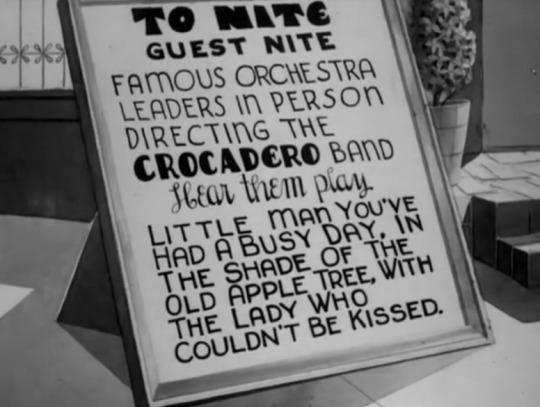
all of the selections are references to pieces of music, with said music serving as accompaniment. the score begins with “little man, you’ve had a busy day”, switches to “in the shade of the old apple tree”, and closes with a carl stalling favorite, “the lady in red”.
pan over to porky, eagerly ogling the sign. volney white’s animation and mel blanc’s vocals combine to make an energetic performance that will only grow in fervor. “hot duh-dee-duh-dee-duh-diggity dog! all thuh-the-thee-the big shots in person!” the detail of porky’s little hat flipping around, staggering in time to his stutter, is not only funny, but elevates the energy of the sequence. “someday, i’m uh-guh-geh-uh-gonna lead a band, too! s-see?”
porky unfurls a diploma, to which we get a close-up of his not-so-trustworthy credentials (fingernails and all):
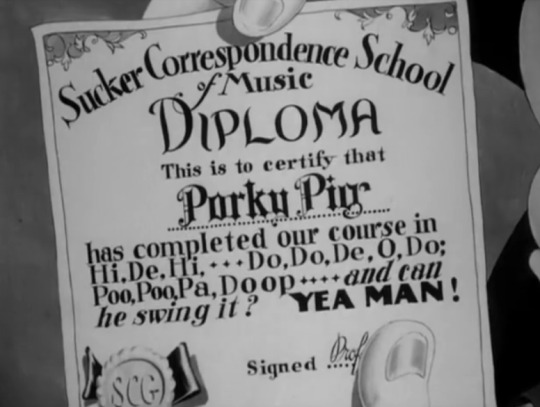
volney’s animation continues to be full of character as porky blabs on about how he’s gonna become a famous bandleader. “and meh-muh-mee-mm-maybe i’ll be eh-feh-eh-famous, like eh-leh-lee-le-leopold eh-seh-stokowski!”
a nice change in camera angles as we turn to an upshot of porky, furiously conducting his imaginary band to a rousing rendition of “poet and peasant overture”.
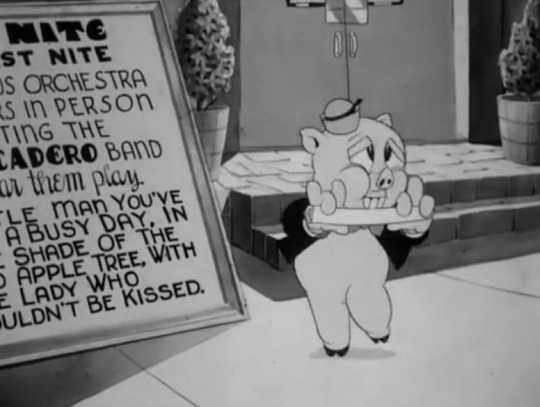
the mood changes from fervent conductor to crooner as he chooses to mimic rudy vallee, conducting along to vallee’s 1937 “vieni, vieni”, complete with a hilariously amiable facial expression--a stark contrast to the fit he was throwing mimicking stokowski just seconds prior.
another seamless transition in tone to an impression of eh-buh-bee-beh-benny goodman, the song this time being “sweet georgia brown” in the stylings of the king of swing himself. the changes in mood and tone, in both the animation and the music, are as smooth as butter, especially for such drastic shifts in expression. frank tashlin doesn’t skip a beat with his pacing. this is especially true as the camera pans over to another nearby sign, a hilarious sight gag quickly putting an end to porky’s festivities:

dejected, porky rifles in his pocket and pulls out a lone coin emblazoned with a skunk—“one scent”. he trudges along solemnly, away from the crocadero, when all of the sudden a sign catches his eye: BOY WANTED. though porky has been slowly growing more consistent in his characterization, his age still fluctuated from picture to picture. frank tashlin would also portray him as a young boy in wholly smoke just a few months later.
tashlin flaunts his need for speed as porky wastes no time doing the signature volney white eye take and darting into the crocadero, a cloud of dust and the swinging of the doors serving as the only indication of his presence just milliseconds prior.

although the sign doesn’t elaborate on what job it is that porky is doing, the tower of dishes blocking the screen as we fade in to the new scene answers any lingering questions. pan out to porky, happily scrubbing away, while his boss, a pretentious walrus whose vocal stylings are hilarious and borderline incomprehensible orders him around. the bargain—if porky does his job, then he can “watch the orrrrrrchestrey, maybe, hmmm?”
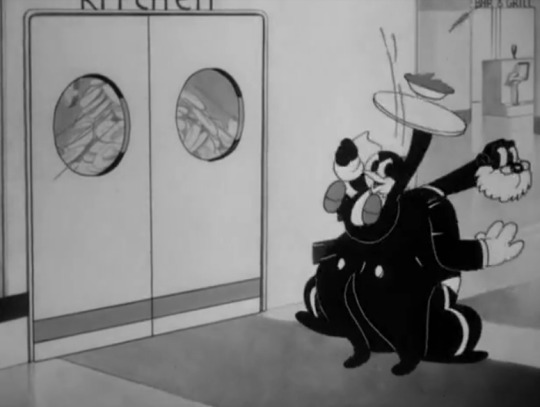
a throwback to the days of working with disney, carl stalling “mickey mouse”’s a little penguin waiter—that is, his quick little steps are fervently timed to the jaunty tinker of an xylophone. the walrus blocks the diminutive penguin, peddling a platter of soup. after they inadvertently do a tango of side-stepping, the penguin wordlessly slides down the walrus’ back, zigzagging around a sea of tables, and right over to a lone giraffe, elevating the table like a car jack to fit the gjraffe’s height. the giraffe laps up his soup with ease. though not the funniest gag ever, tashlin’s quirks—the quick timing, hiding the penguin behind the plethora of tables, etc, make it more endearing.
back to porky, carrying a dangerously tall tower of plates with him. a fly causes him to nearly spill his goods, but ducking in place renders the pig safe. that is, until he throws all of the dishes in the air, swatting the fly spastically. the music cue of porky ducking, looking around to make sure the fly is gone, sounds eerily similar to the stylings of norman spencer, who scored the cartoons up until mid-late 1936.
without a break in pace, porky catches all of the dishes he threw into the air in one fell swoop. more buttery pacing from tashlin, who is able to switch tones and moods at lightning speeds without missing a beat. this is INCREDIBLY difficult to pull off, and he makes it look too easy.

as to be expected, the fly lands right on porky’s snout. instead of attacking it without hesitation, porky slowly reaches for a spoon on the kitchen counter... and THEN disregards his duties as dishwasher, carelessly tossing his pile of dishes aside to swat furiously at his foe.
the pompous walrus from before spots porky’s silhouette from outside the kitchen doors, flailing and waving around like a madman. “der loafer!” his boss interprets porky’s frantic waving of the spoon as a frantic imitation of a bandleader, promptly tossing him out. porky recovers in the back alley, left with his diploma and metaphorical birds of cartoon pain as the boss scolds “today, you are a ham!”--a take on the bar mitzvah declaration “today, you are a man”, which has been spoofed previously in cartoons such as egghead rides again.
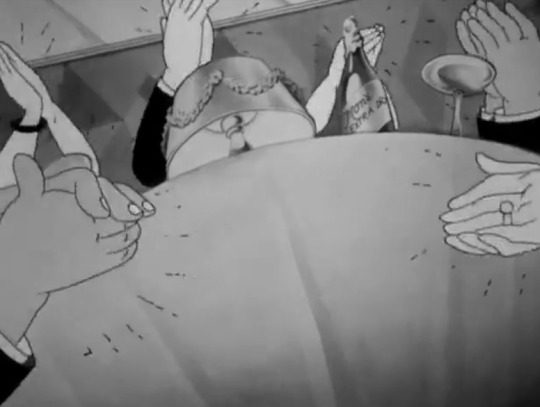
it doesn’t take long for the boss to eat his own words. frank tashlin does a great job of creating a genuinely anxiety inducing mood as a crowd of people, now filling the crocadero, chant “we want mu-sic! we want mu-sic! we want mu-sic!” the musical accompaniment is more akin to the stylings of scott bradley, in the sense that it’s purely atmospheric and contextual, rather than an actual melody. the chanting and disconcerting music get louder as we cut to dramatic up shots of hands clapping to the beat, down shots of foots stamping, etc. it’s genuinely unnerving--and the manager agrees, pacing circles around his office, muttering incoherently to himself about the absence of “the musicmaker”.
knocking on the door serves as a symbol of hope as the manager whips around. “who’s dere?”
“telegram, i bet’cha!” inside bursts a total loon of an old man, his long, white beard whipping in the wind as he does donuts on his bicycle inside the manager’s office. if it weren’t for his looks and speech patterns, which already tell a story, carl stalling’s score of “the woods are full of cuckoos” certifies that this old coot definitely has some screws loose.
the old coot reaches into the depths of his beard and pulls out said telegram. “y’ owe me sixty cents, i bet’cha.” the manager unceremoniously dumps a handful of coins into the coot’s possession, who does a few more donuts in the office, indicating his exit. that is, until he suddenly halts, tipping his hat to bid “g’bye, i bet’cha.” such a scene is nonsense--and it’s hilarious nonsense rather than perplexing nonsense. it makes no sense, and yet it’s speedy enough to get its point across AND not overstay its welcome. had the same gag been executed by someone such as ben hardaway, who probably would have LOVED this gag, it would have been milked to death and bloated to ensure the audience “got it”. here, frank knows when to start and when to stop, an incredibly valuable skill not all directors possess.
contents of the telegram include a rather morbid nod to the hit ‘20s song “i faw down an' go boom”:

to add insult to injury, the old coot sticks his head in the door and adds “yeah, and they won’t come ‘t all, i betcha!” before slamming the door. though i can’t place the animator, the style of the animation looks eerily similar to that of izzy ellis’, from the spiral motion lines to the thin, squished look of his face. izzy ellis would animate in the clampett unit after leaving ub iwerks’ studio, later animating under norm mccabe, frank tashlin himself, bob clampett again, and then bob mckimson. an example of some of his work under frank tashlin here.
back to the crowd, still demanding their music in the same unnerving drone. the manager continues to pace in his office, until a bright idea hits. “that sving dishvasher! i must get him back schnell!”
a moment of frank tashlin greatness: the entire cartoon screeches to a halt as a narrator explains “ladies and gentlmen, ‘schnell’ means ‘quick’!” and, just like that, cartoon hijinks resume. this joke is hilarious 83 years later--imagine the reaction it evoked from theatergoers in 1938. once more, the matter-of-fact execution of the gag is what sells it. no build up, no cool down, no bloating of anything. short, sweet, and to the point. it’s so hilariously and purposefully redundant that you can’t NOT laugh at it.
speaking of quick, that would be an understatement to describe the rapid cutting after the fact. the manager rushes outside, whipping around street corner after street corner to find the dejected dishwasher he berated just minutes prior. he finds his target, grabbing porky and rushing backwards--the same way he came at the same exact lightning speed--all while monologuing about how porky can be a bandleader and break all of the dishes he wants.
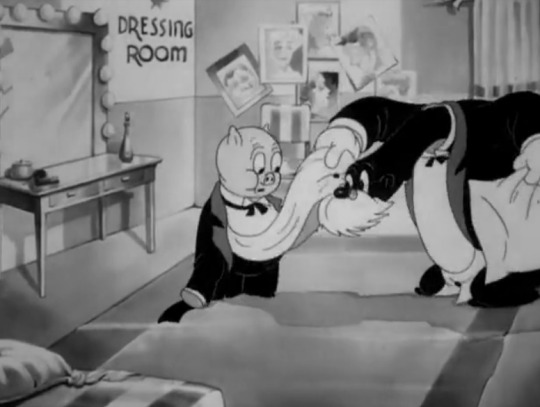
again, no breaks in momentum whatsoever as the bandleader tosses a nonplussed porky into a bandleader’s outfit, stuffing a pillow under his shirt (had this cartoon been made a few months prior, there’d be no need for a pillow!) and giving him a fake mustache/curl of hair via makeup. “pull de vool over dere eyes!”
thus cues the music portion of the cartoon. a spotlight shines on a sign introducing porky as “the jazz king”, much to the pleasure of the audience. a giraffe in the orchestra introduces the song with a clarinet solo of “rhapsody in blue” before getting down to business.
porky, dressed as paul whiteman, conducts whiteman’s “avalon”, as indicated by the music stand. volney white does some great animation here--porky struggles to keep his own weight afloat, his giant pillow-stomach sinking to the ground. he readjusts himself a few times, enjoying the spare seconds of peace where his outfit stays intact, only for the same charade to repeat. fun eye takes and volumetric animation from volney. it’s no coincidence that he was one of tashlin’s best animators.
the crowd shots in this cartoon are not to be overlooked--kudos and apologies for the poor people who had to ink and paint all of that! the crowd dances along to the stylings of porky’s music, including a pair of kangaroos and their joeys slow dancing together.

back to the little penguin waiter from before, tinkering along to deliver a drink. a spare trombone sucks up all of the goods in the glass, prompting a hilarious grimace from the penguin who just stands still, silently glowering before traipsing backwards (mickey mouse timing and all) to refill.
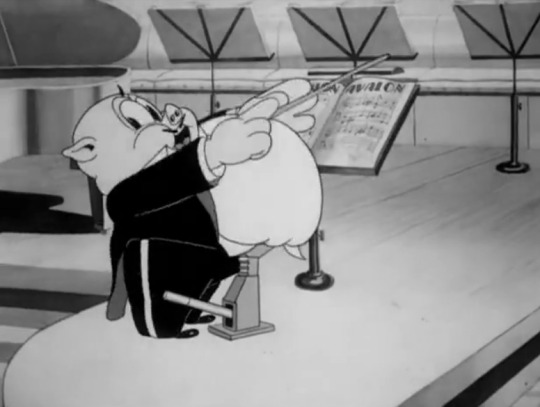
cut to porky, who appears much more jovial. a clever pan out reveals that he’s enlisted in the help of a car jack to keep his extra weight afloat. and, with that, curtains (animation reused from the introduction to tashlin’s porky’s romance) close out on the pig. applause from the audience.
next up, “guy lumbago and his boiled kanadians”, a not-so-flattering nod to guy lombardo and his royal canadians. porky, dressed as a canadian mountee, directs “cryman lumbago”. carmen lombardo, brother to guy, was often poked fun at for the excessive vibrato in his voice--people would liken him to sounding like an old man on his last legs. not only that, but even by the ‘30s, guy lombardo’s music was often dismissed as slow, sappy “old person’s music”. the 1954 woody woodpecker cartoon, real gone woody, also makes fun of lombardo, also dubbing him as “lumbago” and calling him a square.

indeed, cryman lumbago is a decrepit old man with--you guessed it--lumbago, singing in a hilariously obnoxious vibrato. even the dancers in the crocadero stagger along to his vibrato, their dancing stuttering. the benign facial expressions of the crowd, despite all of this, is the perfect cherry on top. one wonders if guy/carmen lombardo ever saw this cartoon, and how they reacted to it...
just as the gag threatens to overstay its welcome (and, admittedly, it has), a screwball assistant who looks like a relative to another random screwball in porky’s duck hunt scoops lumbago into a wheelchair and wheels him off stage. the audience applauds, and there’s a feeling that they aren’t just applauding the music.
cue the most controversial, uncomfortable, yet also complex part of the cartoon: a tribute to cab calloway, or, as he’s dubbed here, cab halloway.
for today i’ll spare you the imagery, but we’re greeted by a (thankfully) rare anomaly in the porky pig-verse: porky and his orchestra are dressed in blackface, conducting a rousing rendition of “chinatown, my chinatown”.
obviously, any and all blackface is abhorrent, but this is an interesting case. it’s clear that this was meant to be an homage and celebration of cab calloway’s music. a certain level of care seems to have been put into this sequence—it’s not a cheap throwaway “haha blackface” gag purely just for laughs. the animation is FILLED with a surprising amount of energy and vitality, and the vocals of the calloway impression are eerily spot on. analyzing the animation from a technical standpoint, it’s VERY skillful. it is NOT easy to convey such high energy and such elasticity. the animation is vivid, rapid, and invigorating. for 1938 especially, such energy is jarring. this feels more like the climax of a 1945 bob clampett cartoon, not a run of the mill 1938 porky pig cartoon.
BUT, with that said, it’s still extremely uncomfortable--blackface is blackface, and just because the techniques behind it are good doesn’t mean the material being animated is good. as i mentioned, the intentions don’t entirely feel as nasty as other examples we have/will seen, but that doesn’t negate the harm it does. you can have affectionate homages to cab calloway and his music without blackface--look at betty boop’s snow white. plus, because the song is “chinatown, my chinatown”, any nuance this scene had is discredited when porky switches from blackface to dressing up as a stereotypical chinese man. uncomfortable and unnecessary--THAT is a cheap throwaway gag.
nevertheless, it’s not in my place to preach about what is racist and what isn’t. speaking purely from a technical standpoint--the techniques and processes that went into the animation itself--this is a very impressive performance. high energy in both music and animation. the elasticity, speed, all of it is very impressive. the content BEING animated, however, has aged like rotten milk. though this isn’t as meanspirited as other instances that we’ll explore, it still absolutely has its problems and definitely encourages mindful thinking.

regardless, the number ends to uproarious applause, and porky successfully lives his dreams of being a bandleader. the cartoon closes on the penguin waiter, once more peddling a drink. just as the offscreen trombone threatens to steal his drink, the penguin swallows it all in one go and blows a raspberry to the trombone as we iris out.
an interesting entry for sure. frank tashlin’s talents cannot and should not be understated--his speed and timing of the cartoon are certifiably one of the most impressive aspects of the cartoon. indeed, a lot of fun music in this one, whether that be underscores or otherwise. the design of the cartoon holds up very well--tashlin’s streamlined backgrounds and layouts are always a treat to look at. porky is very endearing, especially in the beginning with his imitation of all of the bandleaders, and the incomprehensibility of the walrus is too funny not to laugh at.
of course, the elephant in the room is the ending tribute, which we already discussed. from a technical standpoint, the vivacity of the animation should absolutely be commended and appreciated, especially this early on. the music is VERY fun. but blackface is blackface, and it just hasn’t aged well and comes off as uncomfortable--at least--regardless.
with that, whether you choose to watch this cartoon is up to you. i think this is definitely one of tashlin’s best porky cartoons, and despite its gags and references that have now become dated, it still serves as an enjoyable watch. the whole blackface thing, however, is why this isn’t a cartoon i frequent often. i would trepidatiously recommend this, either skip the calloway sequence or watch it with an open mind. in all, a fun cartoon that i unfortunately can’t quite appreciate to its fullest extent.
with all that said, here’s a link!
15 notes
·
View notes